Intensive Therapy of the Lower Limbs and the Trunk in Children with Bilateral Spastic Cerebral Palsy: Comparing a Qualitative Functional and a Functional Approach
Abstract
1. Introduction
2. Materials and Methods
2.1. Study Design
2.2. Participants
2.3. Intervention
2.3.1. Setup and General Guidelines
2.3.2. Functional Approach
2.3.3. Qualitative Functional Approach
2.4. Assessment
2.4.1. Primary Outcomes
2.4.2. Secondary Outcomes
2.4.3. Additional Assessments
2.5. Statistics
3. Results
3.1. Participants
3.2. Treatment Efficacy
3.2.1. Primary Outcomes
3.2.2. Secondary Outcomes
3.2.3. Subgroup Analysis
3.2.4. Matched-Pair Analysis
4. Discussion
5. Study Limitations
6. Conclusions
Author Contributions
Funding
Institutional Review Board Statement
Informed Consent Statement
Data Availability Statement
Acknowledgments
Conflicts of Interest
Appendix A
| Prenatal risk factors |
|
| Perinatal risk factors |
|
| Postnatal risk factors |
|

| Motor Learning Principle | Description |
|---|---|
| Structure | The therapeutic program had a clear structure with a top-down system: five domains, prerequisites, and exercises. |
| Repetition | Six individual sessions for each domain were incorporated into the program. Individual logbooks ensured the repetition of the exercises. |
| Progression | The exercises were progressively graded toward increasing the participants’ capacities. Individual logbooks ensured shaping. |
| Motivation | Motivation was an important factor during the assessments and therapy. Fun was a key feature and was achieved through rewards, group sessions, attractive leisure moments, and the overarching circus theme. |
| Individual adjustments | Individual goals were based on baseline assessments. Each participant had their own logbook to ensure the continuity of the therapy. |
| Therapists guide the execution | The child was considered an active actor seeking problem-solving strategies guided by the therapist. |
| Focus on function | Functional activities took precedence during at least 70% of the therapeutic sessions. |
| Qualitative Functional Approach (Pictures a–d) | Functional Approach (Pictures e–h) | ||
|---|---|---|---|
| Bobath-concept-oriented | Functional-therapy-oriented | ||
| Activity- and impairment-focused | Activity-focused | ||
Active and passive preparation of the function
| No preparation of the function | ||
| Hands-on, facilitation through handling skills, and hands-off Using key points of control to facilitate more efficient, qualitative strategies during the performance of a task | Hands-off adjustment of the environment | ||
| Verbal cues enhance the quality of movement | No verbal cues on the quality of movement during the performance | ||
| Goal setting on impairment and activity level of the International Classification of Functioning, Disability and Health (ICF) (e.g., enhance the extension of the hip in stance and during sit-to-stand or improve going up and down the stairs holding one handrail) | Goal setting on the activity level of the ICF (e.g., sit-to-stand without using the hands or improve transfers from sitting on the ground to standing position) | ||
| a. | b. | e. | f. |
 | 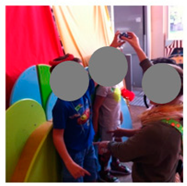 |  | 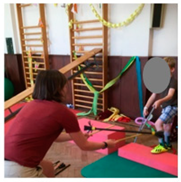 |
| Qualitative functional approach | Functional approach | ||
| c. | d. | g. | h. |
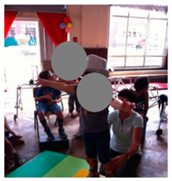 | 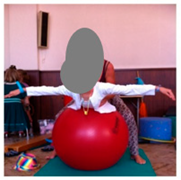 | 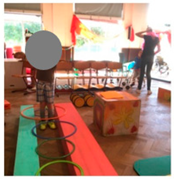 | 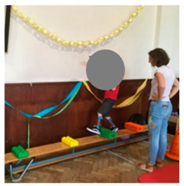 |
| Qualitative functional approach | Functional approach | ||
| Balance | |
| Maintaining balance in different postures Balance in stance with one foot in front (length of one step) Dynamic balance | |
| Transfers | |
| Sit to stand From lying down to stand | Rolling from prone to supine and vice versa Roll-over |
| Trunk stability | Trunk mobility |
| Active upright position of the trunk Maintaining trunk position Trunk stability while moving, in sitting position Trunk stability while moving, in standing position | Trunk mobility in lying position Trunk mobility in sitting position |
| Walking | |
| Stance phase stability: flat foot, knee and hip extension, trunk alignment Stance on 1 leg Stance on 1 leg while moving the other leg Clearance of the foot during the swing phase Pre-position of the foot at the end of the swing phase | Step length Strength of the lower-limb muscles Walking (forward, sideways, and backwards) Transfers (sitting to standing and vice versa) Walking speed |
| Going up and down the stairs | |
| Balance in stance Balance on one leg Stance on a step on one leg, the other leg moves Stance with one foot on a step Pushing up on step | Going up and down the stairs: alternating versus not alternating Jumping from a step Active hip- and knee-extension of the stance leg |
| 8:30 | a.m. | – | 9:00 | a.m. | Briefing therapists |
| 9:00 | a.m. | – | 9:45 | a.m. | Group session 1 (warming up with, e.g., stretching and strengthening) |
| 9:45 | a.m. | – | 10:30 | a.m. | Individual session 1 |
| 10:30 | a.m. | – | 11:00 | a.m. | Break |
| 11:00 | a.m. | – | 11:45 | a.m. | Individual session 2 |
| 11:45 | a.m. | – | 12:45 | p.m. | Lunch break |
| 12:45 | p.m. | – | 1:45 | p.m. | Standing device group A |
| 1:45 | p.m. | – | 2:30 | p.m. | Individual session 3 |
| 2:30 | p.m. | – | 3:00 | p.m. | Break |
| 3:00 | p.m. | – | 3:45 | p.m. | Individual session 4 |
| 3:45 | p.m. | – | 4:00 | p.m. | Break |
| 4:00 | p.m. | – | 4:30 | p.m. | Group session 2 (showing newly achieved skills, preparing the circus show) |
| 4:30 | p.m. | – | 5:15 | p.m. | Briefing therapists |
| 6:30 | p.m. | – | 7:30 | p.m. | Standing device group B |
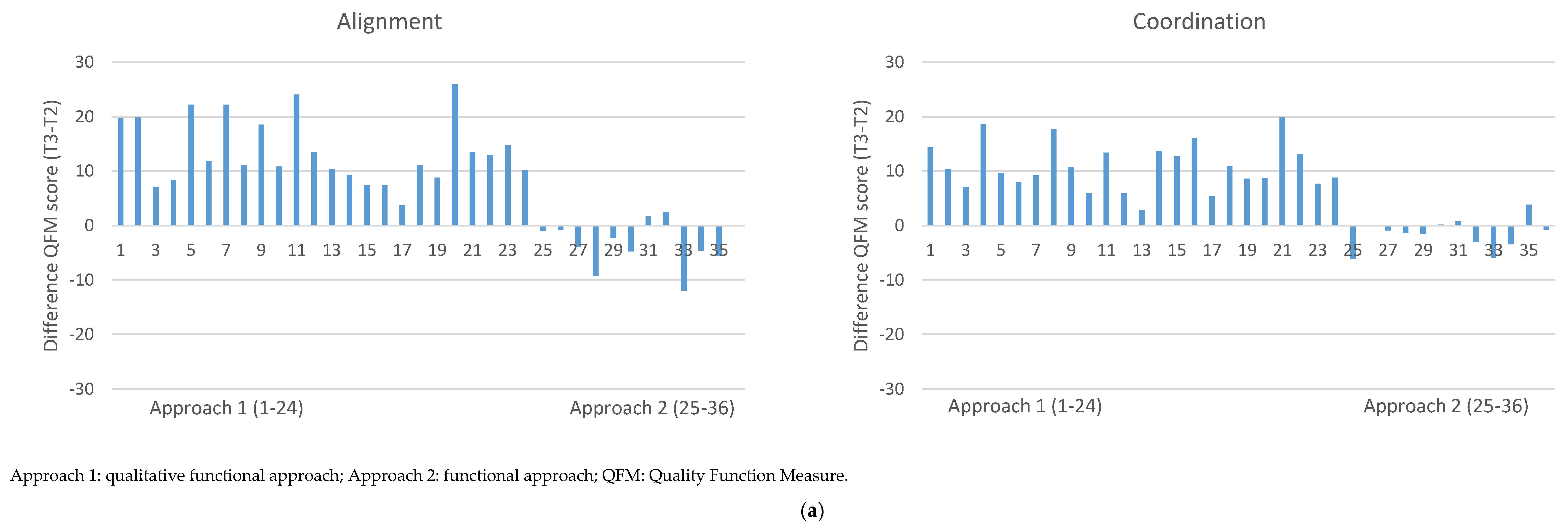
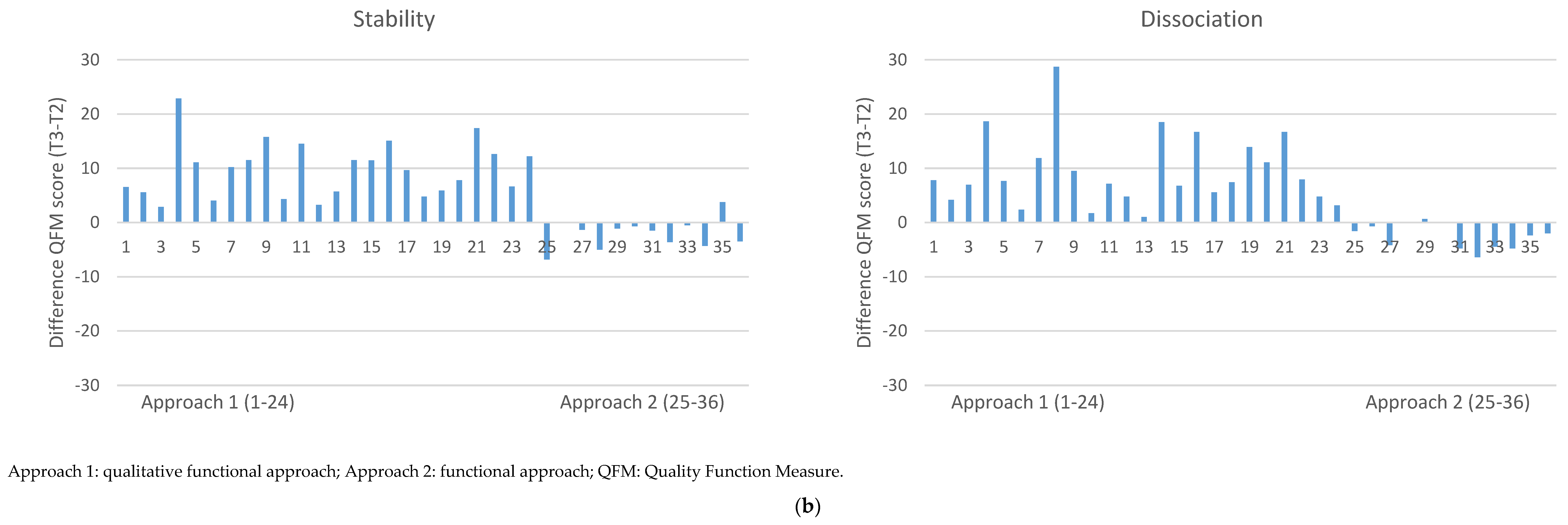

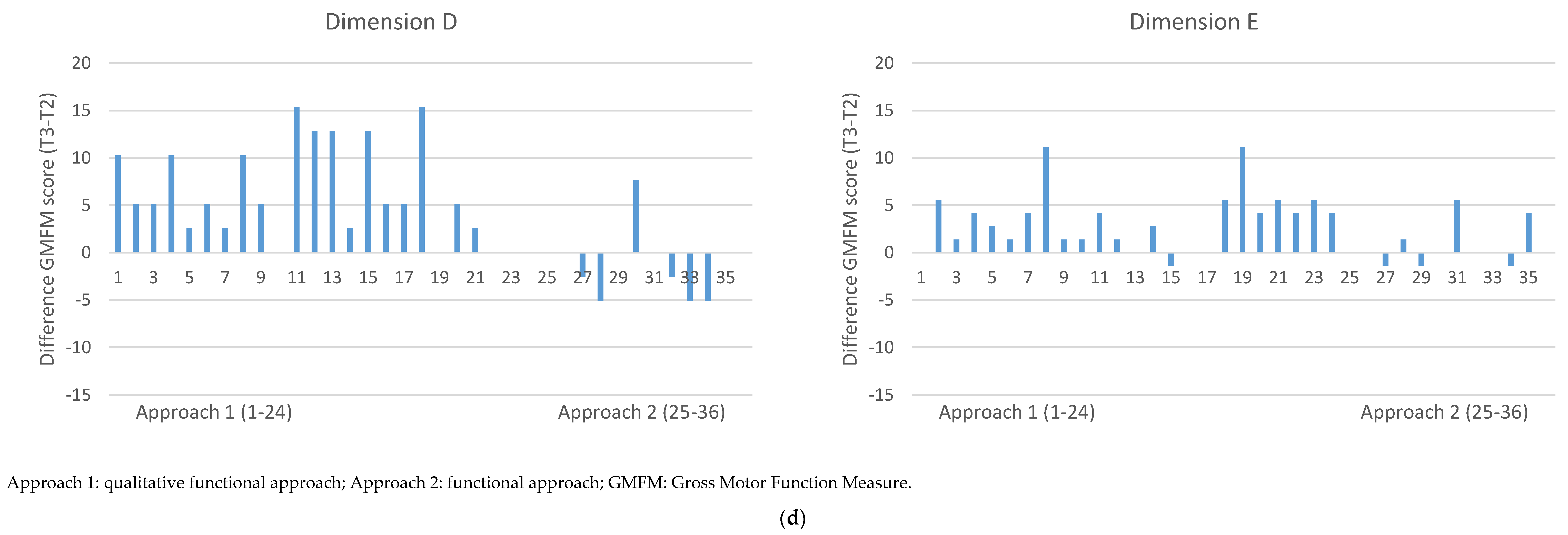
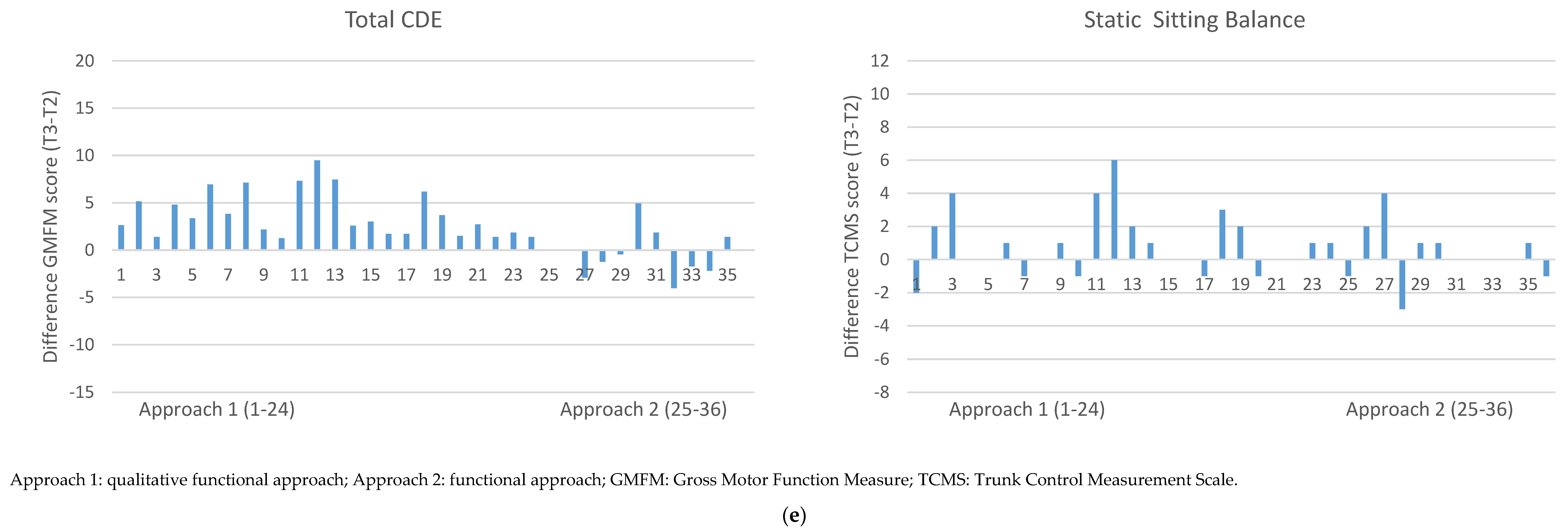
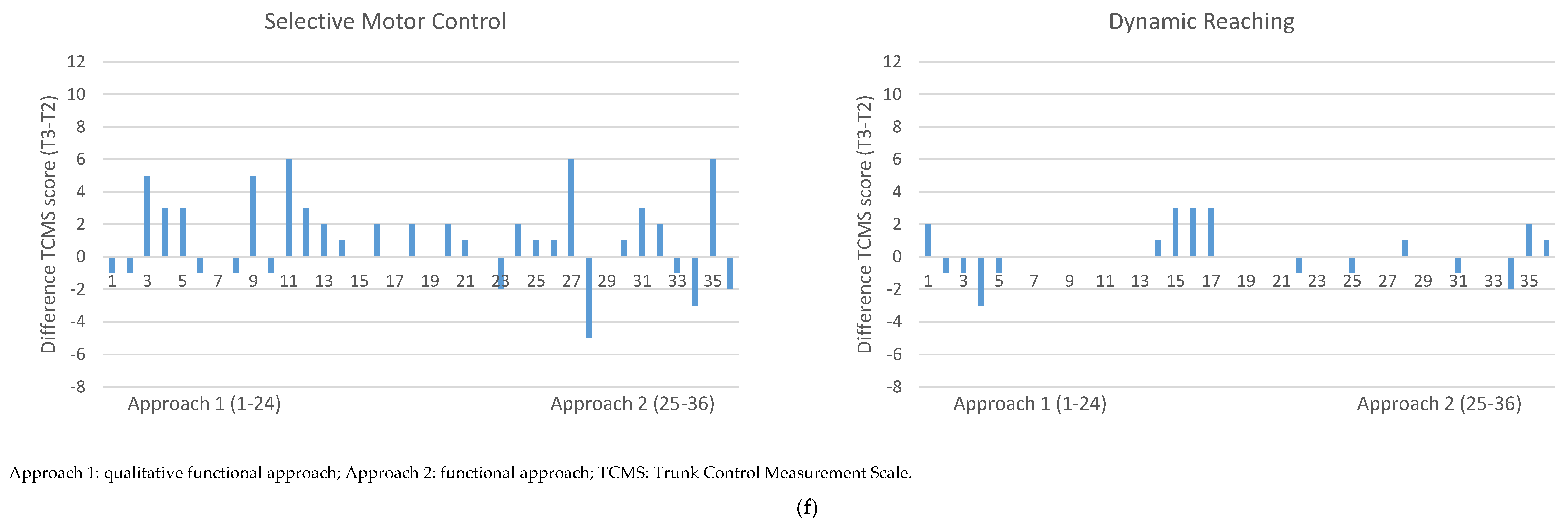
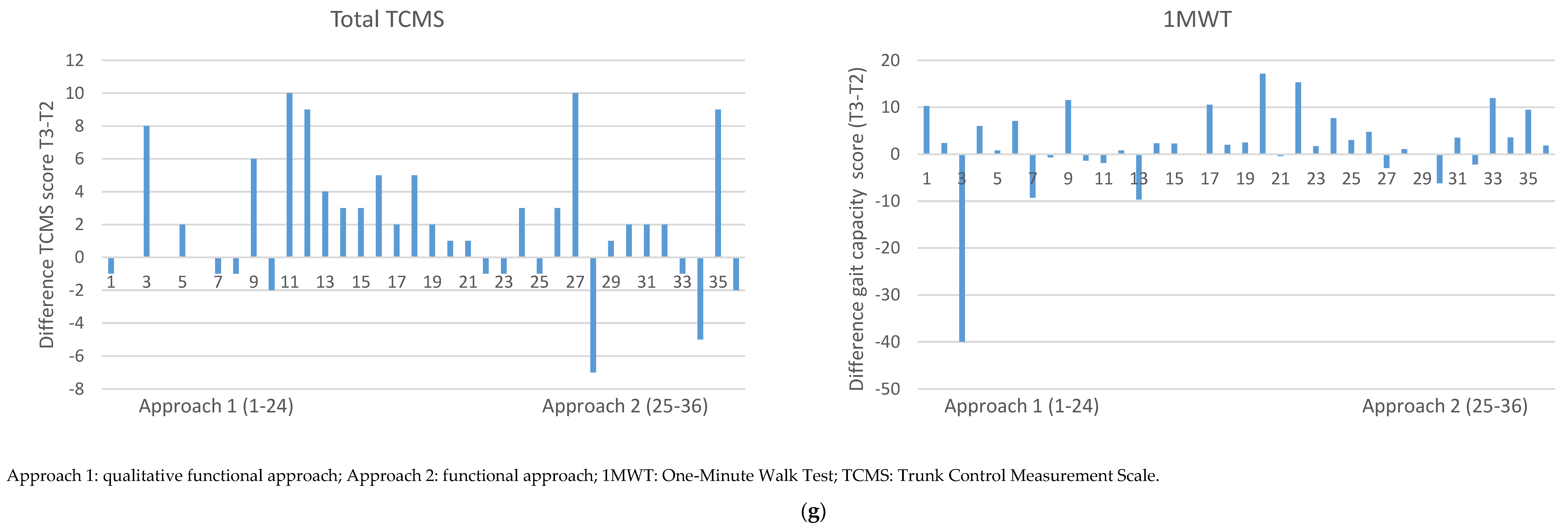
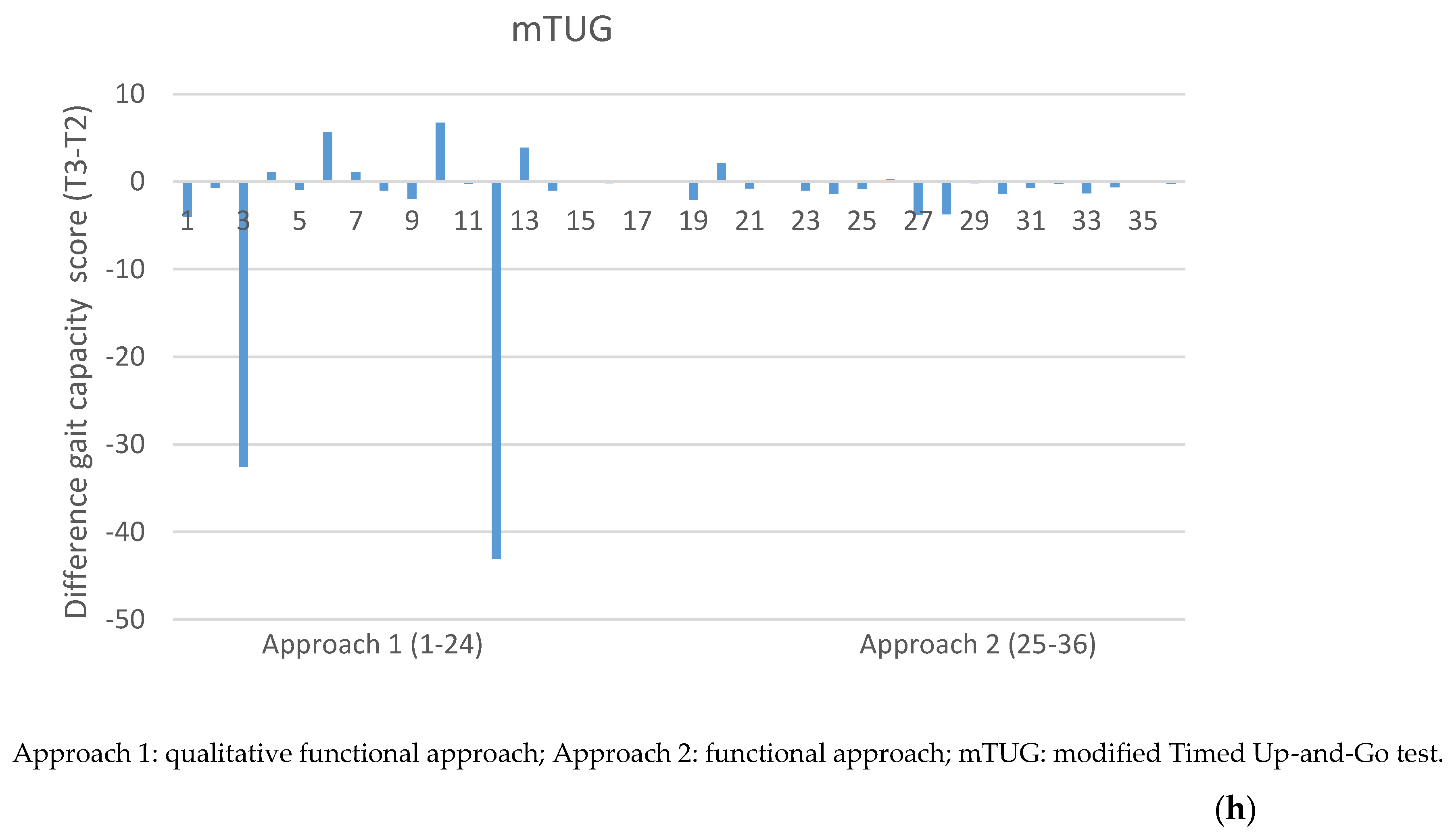
| Alignment | Coordination | Dissociation | Stability | Weight Shift | ||||||||||||||||||
|---|---|---|---|---|---|---|---|---|---|---|---|---|---|---|---|---|---|---|---|---|---|---|
| GMFCS Level | Time A | Time B | Mean Difference (A–B) | Significance | Lower Bound | Upper Bound | Mean Difference (A–B) | Significance | Lower Bound | Upper Bound | Mean Difference (A–B) | Significance | Lower Bound | Upper Bound | Mean Difference (A–B) | Significance | Lower Bound | Upper Bound | Mean Difference (A–B) | Significance | Lower Bound | Upper Bound |
| 2 | 2 | 1 | −3.75 | 0.007 | −7.45 | −0.06 | −1.64 | 0.118 | −4.44 | 1.16 | −4.74 | <0.001 | −8.08 | −1.39 | −2.83 | 0.007 | −5.60 | −0.07 | −1.7 | 0.082 | −4.38 | 0.92 |
| 3 | 1 | 9.29 | <0.001 | 4.21 | 14.38 | 10.91 | <0.001 | 7.01 | 14.81 | 7.15 | <0.001 | 2.54 | 11.76 | 8.98 | <0.001 | 5.14 | 12.82 | 11.65 | <0.001 | 7.98 | 15.33 | |
| 2 | 13.05 | <0.001 | 9.36 | 16.74 | 12.55 | <0.001 | 9.75 | 15.36 | 11.88 | <0.001 | 8.54 | 15.23 | 11.81 | <0.001 | 9.04 | 14.57 | 13.38 | <0.001 | 10.73 | 16.03 | ||
| 4 | 1 | 6.88 | 0.007 | 0.14 | 13.63 | 8.074 | <0.001 | 2.87 | 13.28 | 6.17 | 0.008 | 0.06 | 12.28 | 6.97 | <0.001 | 1.85 | 12.09 | 8.11 | <0.001 | 3.22 | 13.00 | |
| 2 | 10.64 | <0.001 | 4.76 | 16.51 | 9.71 | <0.001 | 5.21 | 14.22 | 10.91 | <0.001 | 5.59 | 16.23 | 9.80 | <0.001 | 5.37 | 14.23 | 9.84 | <0.001 | 5.60 | 14.08 | ||
| 3 | −2.41 | 0.172 | −7.13 | 2.31 | −2.84 | 0.036 | −6.43 | 0.76 | −1.0 | 0.540 | −5.25 | 3.30 | −2.0 | 0.130 | −5.55 | 1.54 | −3.54 | 0.006 | −6.94 | −0.15 | ||
| 3 | 2 | 1 | 1.83 | 0.439 | −4.50 | 8.16 | 0.05 | 0.978 | −4.77 | 4.87 | 2.3 | 0.273 | −3.39 | 8.08 | 0.0 | 0.986 | −4.72 | 4.79 | 0.0 | 0.977 | −4.50 | 4.60 |
| 3 | 1 | 16.16 | <0.001 | 8.39 | 23.94 | 7.97 | <0.001 | 2.01 | 13.93 | 7.52 | 0.005 | 0.48 | 14.56 | 6.27 | 0.005 | 0.40 | 12.13 | 10.71 | <0.001 | 5.10 | 16.32 | |
| 2 | 14.34 | <0.001 | 9.57 | 19.11 | 7.92 | <0.001 | 4.30 | 11.54 | 5.17 | 0.002 | 0.85 | 9.49 | 6.23 | <0.001 | 2.66 | 9.81 | 10.66 | <0.001 | 7.24 | 14.08 | ||
| 4 | 1 | 11.49 | 0.001 | 2.28 | 20.71 | 7.09 | 0.008 | −0.02 | 14.20 | 6.99 | 0.026 | −1.35 | 15.33 | 6.345 | 0.016 | −0.64 | 13.33 | 7.78 | 0.002 | 1.10 | 14.46 | |
| 2 | 9.67 | <0.001 | 2.64 | 16.69 | 7.04 | 0.001 | 1.66 | 12.42 | 4.6 | 0.052 | −1.72 | 11.01 | 6.32 | 0.002 | 1.02 | 11.62 | 7.73 | <0.001 | 2.66 | 12.80 | ||
| 3 | −4.67 | 0.021 | −10.05 | 0.71 | −0.88 | 0.564 | −4.97 | 3.21 | −0.5 | 0.770 | −5.40 | 4.34 | 0.1 | 0.957 | −3.95 | 4.12 | −2.94 | 0.043 | −6.80 | 0.93 | ||
| Alignment | Coordination | Dissociation | Stability | Weight Shift | ||||||||||||||||||
|---|---|---|---|---|---|---|---|---|---|---|---|---|---|---|---|---|---|---|---|---|---|---|
| GMFCS Level | Time A | Time B | Mean Difference (A–B) | Significance | Lower Bound | Upper Bound | Mean Difference (A–B) | Significance | Lower Bound | Upper Bound | Mean Difference (A–B) | Significance | Lower Bound | Upper Bound | Mean Difference (A–B) | Significance | Lower Bound | Upper Bound | Mean Difference (A–B) | Significance | Lower Bound | Upper Bound |
| 2 | 2 | 1 | 3.75 | 0.068 | −1.71 | 9.10 | 2.74 | 0.075 | −1.37 | 6.84 | 3.07 | 0.095 | −1.83 | 7.96 | 1.39 | 0.359 | −2.67 | 5.43 | 4.61 | 0.002 | 0.73 | 8.49 |
| 3 | 1 | 2.37 | 0.394 | −5.08 | 9.82 | 1.24 | 0.559 | −4.46 | 6.95 | 0.04 | 0.989 | −6.71 | 6.78 | −1.06 | 0.614 | −6.67 | 4.56 | 2.95 | 0.143 | −2.43 | 8.33 | |
| 2 | −1.33 | 0.510 | −6.73 | 4.08 | −1.49 | 0.329 | −5.60 | 2.61 | −3.03 | 0.099 | −7.93 | 1.87 | −2.44 | 0.108 | −6.49 | 1.61 | −1.66 | 0.251 | −5.54 | 2.22 | ||
| 4 | 1 | 3.0 | 0.397 | −6.49 | 12.50 | −4.29 | 0.119 | −11.62 | 3.05 | −3.60 | 0.263 | −12.19 | 5.00 | 1.07 | 0.69 | −6.13 | 8.28 | 3.27 | 0.205 | −3.62 | 10.15 | |
| 2 | −0.69 | 0.820 | −8.85 | 7.47 | −7.03 | 0.003 | −13.28 | −0.78 | −6.66 | 0.017 | −14.05 | 0.73 | −0.31 | 0.891 | −6.47 | 5.84 | −1.35 | 0.540 | −7.23 | 4.54 | ||
| 3 | 0.63 | 0.788 | −5.72 | 6.98 | −5.53 | 0.003 | −10.37 | −0.70 | −3.63 | 0.092 | −9.38 | 2.12 | 2.13 | 0.232 | −2.64 | 6.89 | 0.32 | 0.853 | −4.25 | 4.88 | ||
| 3 | 2 | 1 | 2.70 | 0.258 | −3.70 | 9.10 | 2.24 | 0.216 | −2.61 | 7.10 | 1.15 | 0.594 | −4.64 | 6.95 | 0.40 | 0.823 | −4.39 | 5.19 | 1.59 | 0.352 | −3.00 | 6.18 |
| 3 | 1 | −3.45 | 0.294 | −12.26 | 5.36 | 0.65 | 0.797 | −6.11 | 7.40 | −0.71 | 0.811 | −8.69 | 7.27 | −1.11 | 0.653 | −7.76 | 5.54 | 0.38 | 0.872 | −5.98 | 6.74 | |
| 2 | −6.15 | 0.011 | −12.55 | 0.25 | −1.60 | 0.377 | −6.45 | 3.26 | −1.86 | 0.389 | −7.66 | 3.93 | −1.51 | 0.397 | −6.30 | 3.28 | −1.21 | 0.479 | −5.80 | 3.38 | ||
| 4 | 1 | −11.17 | 0.023 | −24.17 | 1.83 | −0.31 | 0.933 | −10.33 | 9.71 | −1.41 | 0.747 | −13.18 | 10.35 | −2.24 | 0.542 | −12.09 | 7.61 | −4.04 | 0.251 | −13.46 | 5.38 | |
| 2 | −13.87 | 0.002 | −25.53 | −2.21 | −2.56 | 0.443 | −11.49 | 6.38 | −2.57 | 0.515 | −13.12 | 7.99 | −2.64 | 0.421 | −11.43 | 6.16 | −5.63 | 0.075 | −14.05 | 2.78 | ||
| 3 | −7.72 | 0.039 | −17.68 | 2.24 | −0.96 | 0.734 | −8.56 | 6.64 | −0.70 | 0.834 | −9.72 | 8.32 | −1.13 | 0.686 | −8.62 | 6.36 | −4.42 | 0.100 | −11.59 | 2.75 | ||
| Dimension C | Dimension D | Dimension E | Total CDE | |||||||||||||||
|---|---|---|---|---|---|---|---|---|---|---|---|---|---|---|---|---|---|---|
| GMFCS Level | Time A | Time B | Mean Difference (A–B) | Significance | Lower Bound | Upper Bound | Mean Difference (A–B) | Significance | Lower Bound | Upper Bound | Mean Difference (A–B) | Significance | Lower Bound | Upper Bound | Mean Difference (A–B) | Significance | Lower Bound | Upper Bound |
| 2 | 2 | 1 | 0.48 | 0.62 | −2.10 | 3.1 | 1.54 | 0.24 | −1.97 | 5.05 | 2.50 | 0.006 | 0.10 | 4.90 | 1.50 | 0.022 | −0.24 | 3.24 |
| 3 | 1 | 0.79 | 0.551 | −2.78 | 4.4 | 7.18 | <0.001 | 2.29 | 12.07 | 6.76 | <0.001 | 3.39 | 10.13 | 4.91 | <0.001 | 2.47 | 7.36 | |
| 2 | 0.32 | 0.741 | −2.26 | 2.9 | 5.64 | <0.001 | 2.13 | 9.15 | 4.26 | <0.001 | 1.86 | 6.66 | 3.40 | <0.001 | 1.67 | 5.15 | ||
| 4 | 1 | 0.86 | 0.628 | −3.89 | 5.6 | 3.85 | 0.116 | −2.69 | 10.39 | 6.24 | <0.001 | 1.72 | 10.77 | 3.61 | 0.004 | 0.32 | 6.90 | |
| 2 | 0.28 | 0.804 | −3.74 | 4.5 | 2.31 | 0.273 | −3.34 | 7.96 | 3.74 | 0.011 | −0.15 | 7.63 | 2.10 | 0.047 | −0.69 | 4.93 | ||
| 3 | 0.16 | 0.958 | −3.24 | 3.4 | −3.33 | 0.049 | −7.83 | 1.17 | −0.52 | 0.652 | −3.61 | 2.57 | −1.30 | 0.12 | −3.54 | 0.94 | ||
| 3 | 2 | 1 | 1.16 | 0.481 | −3.27 | 5.6 | 3.85 | 0.089 | −2.20 | 9.89 | 2.25 | 0.147 | −1.90 | 6.40 | 2.32 | 0.04 | −0.69 | 5.33 |
| 3 | 1 | 5.66 | 0.006 | 0.21 | 11.1 | 10.68 | <0.001 | 3.21 | 18.16 | 4.10 | 0.034 | −1.04 | 9.25 | 6.71 | <0.001 | 2.98 | 10.45 | |
| 2 | 4.50 | <0.001 | 1.17 | 7.8 | 6.83 | <0.001 | 2.31 | 11.37 | 1.85 | 0.111 | −1.25 | 4.96 | 4.40 | <0.001 | 2.15 | 6.64 | ||
| 4 | 1 | 1.39 | 0.565 | −5.09 | 7.9 | 7.94 | 0.018 | −0.98 | 16.87 | 2.91 | 0.207 | −3.26 | 9.08 | 4.06 | 0.017 | −0.43 | 8.55 | |
| 2 | 0.23 | 0.901 | −4.70 | 5.2 | 4.10 | 0.105 | −2.65 | 10.85 | 0.66 | 0.702 | −3.99 | 5.31 | 1.74 | 0.168 | −1.63 | 5.11 | ||
| 3 | −4.27 | 0.003 | −8.03 | −0.5 | −2.74 | 0.153 | −7.86 | 2.38 | −1.19 | 0.363 | −4.70 | 2.32 | −2.66 | 0.006 | −5.20 | −0.11 | ||
| Dimension C | Dimension D | Dimension E | Total CDE | |||||||||||||||
|---|---|---|---|---|---|---|---|---|---|---|---|---|---|---|---|---|---|---|
| GMFCS Level | Time A | Time B | Mean Difference (A–B) | Significance | Lower Bound | Upper Bound | Mean Difference (A–B) | Significance | Lower Bound | Upper Bound | Mean Difference (A–B) | Significance | Lower Bound | Upper Bound | Mean Difference (A–B) | Significance | Lower Bound | Upper Bound |
| 2 | 2 | 1 | 0.68 | 0.628 | −3.1 | 4.5 | 1.10 | 0.565 | −4.04 | 6.23 | 3.77 | 0.005 | 0.25 | 7.29 | 1.85 | 0.053 | −0.70 | 4.40 |
| 3 | 1 | −0.68 | 0.727 | −5.90 | 4.5 | 0.00 | 1.000 | −7.16 | 7.16 | 4.76 | 0.011 | −0.17 | 9.69 | 1.36 | 0.308 | −2.22 | 4.94 | |
| 2 | −1.36 | 0.334 | −5.14 | 2.4 | −1.10 | 0.565 | −6.23 | 4.04 | 0.99 | 0.449 | −2.53 | 4.51 | −0.49 | 0.606 | −3.04 | 2.06 | ||
| 4 | 1 | 0.74 | 0.767 | −5.95 | 7.4 | 2.49 | 0.469 | −6.72 | 11.70 | 3.05 | 0.201 | −3.33 | 9.42 | 2.11 | 0.223 | −2.53 | 6.75 | |
| 2 | 0.06 | 0.978 | −5.66 | 5.8 | 1.39 | 0.634 | −6.45 | 9.23 | −0.72 | 0.720 | −6.12 | 4.68 | 0.26 | 0.857 | −3.66 | 4.18 | ||
| 3 | 1.42 | 0.391 | −3.02 | 5.9 | 2.49 | 0.270 | −3.56 | 8.54 | −1.71 | 0.269 | −5.87 | 2.44 | 0.86 | 0.502 | −2.26 | 3.76 | ||
| 3 | 2 | 1 | 2.86 | 0.088 | −1.61 | 7.3 | −2.05 | 0.365 | −8.13 | 4.03 | 0.28 | 0.858 | −3.89 | 4.44 | 0.36 | 0.747 | −2.65 | 3.37 |
| 3 | 1 | 3.33 | 0.150 | −2.85 | 9.5 | −3.08 | 0.330 | −11.55 | 5.39 | 0.28 | 0.898 | −5.56 | 6.11 | 0.18 | 0.910 | −4.06 | 4.41 | |
| 2 | 0.48 | 0.774 | −3.99 | 4.9 | −1.03 | 0.650 | −7.10 | 5.05 | 0.00 | 1.000 | −4.16 | 4.16 | −0.18 | 0.870 | −3.20 | 2.83 | ||
| 4 | 1 | 4.35 | 0.204 | −4.80 | 13.5 | −2.99 | 0.524 | −15.57 | 9.59 | 0.38 | 0.908 | −8.32 | 9.07 | 0.59 | 0.801 | −5.73 | 6.92 | |
| 2 | 1.49 | 0.625 | −6.69 | 9.7 | −0.94 | 0.822 | −12.14 | 10.26 | 0.10 | 0.973 | −7.62 | 7.81 | 0.23 | 0.911 | −5.37 | 5.83 | ||
| 3 | 1.01 | 0.697 | −5.96 | 8.0 | 0.09 | 0.980 | −9.44 | 9.61 | 0.10 | 0.968 | −6.45 | 6.64 | 0.42 | 0.814 | −4.33 | 5.16 | ||
| Static Sitting Balance | Selective Motor Control | Dynamic Reaching | Total TCMS | |||||||||||||||
|---|---|---|---|---|---|---|---|---|---|---|---|---|---|---|---|---|---|---|
| GMFCS Level | Time A | Time B | Mean Difference (A–B) | Significance | Lower Bound | Upper Bound | Mean Difference (A–B) | Significance | Lower Bound | Upper Bound | Mean Difference (A–B) | Significance | Lower Bound | Upper Bound | Mean Difference (A–B) | Significance | Lower Bound | Upper Bound |
| 2 | 2 | 1 | −0.30 | 0.533 | −1.42 | 0.88 | 1.73 | 0.015 | −0.16 | 3.62 | 0.87 | 0.012 | −0.05 | 1.8 | 2.33 | 0.018 | −0.27 | 4.94 |
| 3 | 1 | 0.30 | 0.562 | −1.21 | 1.87 | 2.93 | 0.001 | 0.54 | 5.33 | 1.20 | 0.003 | 0.14 | 2.3 | 4.47 | 0.001 | 1.01 | 7.93 | |
| 2 | 0.60 | 0.163 | −0.55 | 1.75 | 1.20 | 0.090 | −0.69 | 3.09 | 0.33 | 0.329 | −0.58 | 1.3 | 2.13 | 0.030 | −0.47 | 4.74 | ||
| 4 | 1 | 1.10 | 0.140 | −0.89 | 3.11 | 2.99 | 0.009 | 0.01 | 6.99 | 1.01 | 0.034 | −0.26 | 2.3 | 5.02 | 0.003 | 0.56 | 9.49 | |
| 2 | 1.37 | 0.040 | −0.40 | 3.15 | 1.33 | 0.225 | −1.51 | 4.02 | 0.15 | 0.748 | −1.08 | 1.4 | 2.7 | 0.073 | −1.31 | 6.68 | ||
| 3 | 0.80 | 0.154 | −0.68 | 2.23 | 0.06 | 0.947 | −2.28 | 2.40 | −0.19 | 0.651 | −1.29 | 0.9 | 0.6 | 0.651 | −2.73 | 3.83 | ||
| 3 | 2 | 1 | 0.70 | 0.229 | −0.82 | 2.15 | 0.89 | 0.328 | −1.55 | 3.33 | 0.33 | 0.449 | −0.85 | 1.5 | 1.9 | 0.133 | −1.47 | 5.25 |
| 3 | 1 | 2.11 | 0.005 | 0.12 | 4.10 | 2.22 | 0.056 | −0.87 | 5.31 | 0.33 | 0.516 | −1.04 | 1.7 | 4.67 | 0.006 | 0.20 | 9.13 | |
| 2 | 1.44 | 0.010 | −0.04 | 2.93 | 1.33 | 0.144 | −1.10 | 3.77 | 0.00 | 1.00 | −1.18 | 1.2 | 2.78 | 0.028 | −0.58 | 6.14 | ||
| 4 | 1 | 3.24 | 0.001 | 0.72 | 5.76 | 2.68 | 0.059 | −1.09 | 6.46 | −0.18 | 0.769 | −1.77 | 1.4 | 5.83 | 0.006 | 0.20 | 11.45 | |
| 2 | 2.57 | 0.002 | 0.35 | 4.80 | 1.80 | 0.167 | −1.67 | 5.36 | −0.51 | 0.377 | −2.05 | 1.0 | 3.94 | 0.037 | −1.06 | 8.93 | ||
| 3 | 1.10 | 0.093 | −0.66 | 2.92 | 0.46 | 0.668 | −2.43 | 3.35 | −0.51 | 0.320 | −1.88 | 0.9 | 1.2 | 0.442 | −2.88 | 5.20 | ||
| Static Sitting Balance | Selective Motor Control | Dynamic Reaching | Total TCMS | |||||||||||||||
|---|---|---|---|---|---|---|---|---|---|---|---|---|---|---|---|---|---|---|
| GMFCS Level | Time A | Time B | Mean Difference (A–B) | Significance | Lower Bound | Upper Bound | Mean Difference (A–B) | Significance | Lower Bound | Upper Bound | Mean Difference (A–B) | Significance | Lower Bound | Upper Bound | Mean Difference (A–B) | Significance | Lower Bound | Upper Bound |
| 2 | 2 | 1 | −0.14 | 0.820 | −1.83 | 1.54 | −1.29 | 0.213 | −4.05 | 1.48 | 0.14 | 0.775 | −1.20 | 1.49 | −1.30 | 0.366 | −5.10 | 2.53 |
| 3 | 1 | −0.14 | 0.865 | −2.40 | 2.11 | −0.29 | 0.827 | −3.79 | 3.22 | 0.00 | 1.000 | −1.56 | 1.56 | −0.40 | 0.821 | −5.49 | 4.63 | |
| 2 | 0.00 | 1.000 | −1.68 | 1.68 | 1.00 | 0.332 | −1.76 | 3.6 | −0.14 | 0.775 | −1.49 | 1.20 | 0.90 | 0.546 | −2.96 | 4.67 | ||
| 4 | 1 | 0.328 | 0.798 | −2.68 | 3.25 | 0.54 | 0.748 | −3.92 | 4.99 | 0.81 | 0.255 | −1.08 | 2.69 | 1.70 | 0.489 | −4.91 | 8.33 | |
| 2 | 0.403 | 0.666 | −2.22 | 3.07 | 1.82 | 0.237 | −2.29 | 5.93 | 0.66 | 0.332 | −1.16 | 2.49 | 3.0 | 0.178 | −2.94 | 8.94 | ||
| 3 | 0.43 | 0.600 | −1.75 | 2.60 | 0.82 | 0.530 | −2.68 | 4.32 | 0.81 | 0.191 | −0.84 | 2.45 | 2.10 | 0.244 | −2.77 | 7.06 | ||
| 3 | 2 | 1 | 0.20 | 0.787 | −1.79 | 2.19 | −0.40 | 0.742 | −3.67 | 2.87 | 0.20 | 0.735 | −1.39 | 1.79 | 0.00 | 1.000 | −4.51 | 4.51 |
| 3 | 1 | 1.00 | 0.316 | −1.67 | 3.67 | 0.00 | 1.000 | −4.15 | 4.15 | 0.40 | 0.561 | −1.44 | 2.24 | 1.40 | 0.531 | −4.59 | 7.39 | |
| 2 | 0.80 | 0.282 | −1.19 | 2.79 | 0.40 | 0.742 | −2.87 | 3.67 | 0.20 | 0.735 | −1.39 | 1.79 | 1.40 | 0.405 | −3.11 | 5.91 | ||
| 4 | 1 | 2.10 | 0.106 | −1.36 | 5.57 | 2.04 | 0.296 | −3.17 | 7.24 | 0.37 | 0.651 | −1.83 | 2.58 | 4.80 | 0.099 | −2.94 | 12.54 | |
| 2 | 1.90 | 0.100 | −1.18 | 4.99 | 2.44 | 0.176 | −2.36 | 7.23 | 0.17 | 0.827 | −1.96 | 2.30 | 4.80 | 0.065 | −2.12 | 11.72 | ||
| 3 | 1.10 | 0.241 | −1.42 | 3.62 | 2.04 | 0.180 | −2.02 | 6.10 | −0.03 | 0.970 | −1.94 | 1.89 | 3.40 | 0.111 | −2.29 | 9.09 | ||
| 1MWT | mTUG | |||||||||
|---|---|---|---|---|---|---|---|---|---|---|
| GMFCS Level | Time A | Time B | Mean Difference (A–B) | Significance | Lower Bound | Upper Bound | Mean Difference (A–B) | Significance | Lower Bound | Upper Bound |
| 2 | 2 | 1 | −3.23 | 0.046 | −7.55 | 1.08 | 0.10 | 0.945 | −3.82 | 4.02 |
| 3 | 1 | 0.59 | 0.787 | −5.27 | 6.45 | −0.66 | 0.742 | −6.03 | 4.71 | |
| 2 | 3.83 | 0.019 | −0.49 | 8.14 | −0.76 | 0.604 | −4.68 | 3.17 | ||
| 4 | 1 | 1.93 | 0.501 | −5.75 | 9.62 | −0.85 | 0.749 | −7.93 | 6.24 | |
| 2 | 5.17 | 0.042 | −1.60 | 11.93 | −0.95 | 0.683 | −7.15 | 5.26 | ||
| 3 | 1.34 | 0.511 | −4.14 | 6.82 | −0.19 | 0.92 | −5.19 | 4.81 | ||
| 3 | 2 | 1 | 1.78 | 0.39 | −3.79 | 7.35 | 2.38 | 0.208 | −2.68 | 7.45 |
| 3 | 1 | 4.45 | 0.128 | −3.35 | 12.24 | −0.92 | 0.729 | −8.07 | 6.22 | |
| 2 | 2.67 | 0.225 | −3.22 | 8.55 | −3.31 | 0.099 | −8.66 | 2.05 | ||
| 4 | 1 | 6.18 | 0.094 | −3.64 | 15.99 | −4.85 | 0.153 | −13.91 | 4.21 | |
| 2 | 4.39 | 0.173 | −4.22 | 13.00 | −7.23 | 0.015 | −15.14 | 0.67 | ||
| 3 | 1.73 | 0.492 | −5.02 | 8.47 | −3.93 | 0.088 | −10.08 | 2.22 | ||
| 1MWT | mTUG | |||||||||
|---|---|---|---|---|---|---|---|---|---|---|
| GMFCS Level | Time A | Time B | Mean Difference (A–B) | Significance | Lower Bound | Upper Bound | Mean Difference (A–B) | Significance | Lower Bound | Upper Bound |
| 2 | 2 | 1 | 1.05 | 0.655 | −5.27 | 7.36 | −0.27 | 0.901 | −6.01 | 5.48 |
| 3 | 1 | 3.78 | 0.238 | −4.79 | 12.35 | −0.67 | 0.82 | −8.53 | 7.20 | |
| 2 | 2.73 | 0.247 | −3.58 | 9.05 | −0.40 | 0.852 | −6.14 | 5.34 | ||
| 4 | 1 | 5.52 | 0.173 | −5.28 | 16.32 | 0.26 | 0.944 | −9.71 | 10.23 | |
| 2 | 4.47 | 0.203 | −4.92 | 13.86 | 0.53 | 0.869 | −8.08 | 9.14 | ||
| 3 | 1.74 | 0.527 | −5.65 | 9.13 | 0.93 | 0.712 | −5.81 | 7.66 | ||
| 3 | 2 | 1 | 0.73 | 0.794 | −6.75 | 8.20 | −0.67 | 0.792 | −7.46 | 6.13 |
| 3 | 1 | 2.45 | 0.518 | −7.70 | 12.59 | −2.64 | 0.447 | −11.94 | 6.66 | |
| 2 | 1.72 | 0.536 | −5.75 | 9.20 | −1.98 | 0.436 | −8.77 | 4.82 | ||
| 4 | 1 | 8.52 | 0.126 | −6.32 | 23.35 | −1.81 | 0.722 | −15.48 | 11.85 | |
| 2 | 7.79 | 0.122 | −5.63 | 21.22 | −1.15 | 0.803 | −13.45 | 11.16 | ||
| 3 | 6.07 | 0.160 | −5.47 | 17.61 | 0.83 | 0.833 | −9.71 | 11.37 | ||
| Time * Approach | Qualitative Functional Approach | Functional Approach | |
|---|---|---|---|
| Quality Function Measure (QFM) | |||
| Alignment | <0.001 | <0.001 | 0.400 |
| Coordination | <0.001 | <0.001 | 0.007 |
| Dissociation | <0.001 | <0.001 | 0.130 |
| Stability | <0.001 | <0.001 | 0.209 |
| Weight shift | <0.001 | <0.001 | 0.150 |
| Gross Motor Function Measurement (GMFM) | |||
| Dimension C | 0.008 | 0.003 | 0.475 |
| Dimension D | 0.007 | 0.003 | 0.635 |
| Dimension E | 0.097 | <0.001 | 0.087 |
| Total CDE | <0.001 | <0.001 | 0.303 |
| Trunk Control Measurement Scale (TCMS) | |||
| Static sitting balance | 0.773 | 0.189 | 0.469 |
| Selective movement control | 0.230 | 0.124 | 0.212 |
| Dynamic reaching | 0.234 | 0.111 | 0.689 |
| Total TCMS | 0.109 | 0.029 | 0.109 |
| Gait Capacity | |||
| 1MWT | 0.442 | 0.146 | 0.208 |
| mTUG | 0.520 | 0.201 | 0.926 |
References
- Oskoui, M.; Coutinho, F.; Dykeman, J.; Jette, N.; Pringsheim, T. An update on the prevalence of cerebral palsy: A systematic review and meta-analysis. Dev. Med. Child Neurol. 2013, 55, 509–519. [Google Scholar] [CrossRef] [PubMed]
- Cans, C.; Guillem, P.; Baille, F.; Arnaud, C.; Chalmers, J.; Cussen, G.; McManus, V.; Parkes, J.; Dolk, H. Surveillance of cerebral palsy in Europe: A collaboration of cerebral palsy surveys and registers. Dev. Med. Child Neurol. 2000, 42, 816–824. [Google Scholar] [CrossRef]
- Himmelmann, K.; Uvebrant, P. The panorama of cerebral palsy in Sweden part XII shows that patterns changed in the birth years 2007–2010. Acta Paediatr. 2018, 107, 462–468. [Google Scholar] [CrossRef] [PubMed]
- Germany, L.; Ehlinger, V.; Klapouszczak, D.; Delobel, M.; Hollody, K.; Sellier, E.; De La Cruz, J.; Alberge, C.; Genolini, C.; Arnaud, C. Trends in prevalence and characteristics of post-neonatal cerebral palsy cases: A European registry-based study. Res. Dev. Disabil. 2013, 34, 1669–1677. [Google Scholar] [CrossRef]
- Chopra, M.; Gable, D.L.; Love-Nichols, J.; Tsao, A.; Rockowitz, S.; Sliz, P.; Barkoudah, E.; Bastianelli, L.; Coulter, D.; Davidson, E.; et al. Mendelian etiologies identified with whole exome sequencing in cerebral palsy. Ann. Clin. Transl. Neurol. 2022, 9, 193–205. [Google Scholar] [CrossRef]
- Rosenbaum, P.; Paneth, N.; Leviton, A.; Goldstein, M.; Bax, M. A report: The definition and classification of cerebral palsy—April 2006. Dev. Med. Child Neurol. 2007, 49, 8–14. [Google Scholar] [CrossRef]
- Smithers-Sheedy, H.; Badawi, N.; Blair, E.; Cans, C.; Himmelmann, K.; Krageloh-Mann, I.; Mcintyre, S.; Slee, J.; Uldall, P.; Watson, L.; et al. What constitutes cerebral palsy in the twenty-first century? Dev. Med. Child Neurol. 2014, 56, 323–328. [Google Scholar] [CrossRef]
- Franki, I.; Desloovere, K.; De Cat, J.; Feys, H.; Molenaers, G.; Calders, P.; Vanderstraeten, G.; Himpens, E.; Van den Broeck, C. The Evidence-Base for Conceptual Approaches and Additional Therapies Targeting Lower Limb Function in Children with Cerebral Palsy: A Systematic Review Using the International Classification of Functioning, Disability and Health as a Framework. J. Rehabil. Med. 2012, 44, 396–405. [Google Scholar] [CrossRef]
- Trabacca, A.; Vespino, T.; Di Liddo, A.; Russo, L. Multidisciplinary rehabilitation for patients with cerebral palsy: Improving long-term care. J. Multidiscip. Health 2016, 9, 455–462. [Google Scholar] [CrossRef]
- Dewar, R.; Love, S.; Johnston, L.M. Exercise interventions improve postural control in children with cerebral palsy: A systematic review. Dev. Med. Child Neurol. 2015, 57, 504–520. [Google Scholar] [CrossRef]
- Novak, I.; Mcintyre, S.; Morgan, C.; Campbell, L.; Dark, L.; Morton, N.; Stumbles, E.; Wilson, S.A.; Goldsmith, S. A systematic review of interventions for children with cerebral palsy: State of the evidence. Dev. Med. Child Neurol. 2013, 55, 885–910. [Google Scholar] [CrossRef] [PubMed]
- Novak, I.; Morgan, C.; Fahey, M.; Finch-Edmondson, M.; Galea, C.; Hines, A.; Langdon, K.; Namara, M.M.; Paton, M.C.; Popat, H.; et al. State of the Evidence Traffic Lights 2019: Systematic Review of Interventions for Preventing and Treating Children with Cerebral Palsy. Curr. Neurol. Neurosci. Rep. 2020, 20, 3. [Google Scholar] [CrossRef] [PubMed]
- Anttila, H.; Autti-Ramo, I.; Suoranta, J.; Makela, M.; Malmivaara, A. Effectiveness of physical therapy interventions for children with cerebral palsy: A systematic review. BMC Pediatr. 2008, 8, 14. [Google Scholar] [CrossRef] [PubMed]
- Geijen, M.; Ketelaar, M.; Sakzewski, L.; Palisano, R.; Rameckers, E. Defining Functional Therapy in Research Involving Children with Cerebral Palsy: A Systematic Review. Phys. Occup. Ther. Pediatr. 2020, 40, 231–246. [Google Scholar] [CrossRef]
- Ketelaar, M.; Vermeer, A.; Hart, H.; van Petegem-van Beek, E.; Helders, P.J. Effects of a functional therapy program on motor abilities of children with cerebral palsy. Phys. Ther. 2001, 81, 1534–1545. [Google Scholar] [CrossRef]
- Salem, Y.; Godwin, E.M. Effects of task-oriented training on mobility function in children with cerebral palsy. NeuroRehabilitation 2009, 24, 307–313. [Google Scholar] [CrossRef]
- Butler, C.; Darrah, J. Effects of neurodevelopmental treatment (NDT) for cerebral palsy: An AACPDM evidence report. Dev. Med. Child Neurol. 2001, 43, 778–790. [Google Scholar] [CrossRef]
- Myrhaug, H.T.; Ostensjo, S.; Larun, L.; Odgaard-Jensen, J.; Jahnsen, R. Intensive training of motor function and functional skills among young children with cerebral palsy: A systematic review and meta-analysis. BMC Pediatr. 2014, 14, 292. [Google Scholar] [CrossRef]
- Arpino, C.; Vescio, M.F.; De Luca, A.; Curatolo, P. Efficacy of intensive versus nonintensive physiotherapy in children with cerebral palsy: A meta-analysis. Int. J. Rehabil. Res. 2010, 33, 165–171. [Google Scholar] [CrossRef]
- Bleyenheuft, Y.; Arnould, C.; Brandao, M.B.; Bleyenheuft, C.; Gordon, A.M. Hand and Arm Bimanual Intensive Therapy Including Lower Extremity (HABIT-ILE) in Children With Unilateral Spastic Cerebral Palsy: A Randomized Trial. Neurorehab. Neural Repair 2015, 29, 645–657. [Google Scholar] [CrossRef]
- Bleyenheuft, Y.; Ebner-Karestinos, D.; Surana, B.; Paradis, J.; Sidiropoulos, A.; Renders, A.; Friel, K.M.; Brandao, M.; Rameckers, E.; Gordon, A.M. Intensive upper- and lower-extremity training for children with bilateral cerebral palsy: A quasi-randomized trial. Dev. Med. Child Neurol. 2017, 59, 625–633. [Google Scholar] [CrossRef]
- Heyrman, L.; Desloovere, K.; Molenaers, G.; Verheyden, G.; Klingels, K.; Monbaliu, E.; Feys, H. Clinical characteristics of impaired trunk control in children with spastic cerebral palsy. Res. Dev. Disabil. 2013, 34, 327–334. [Google Scholar] [CrossRef]
- Franki, I.; Van den Broeck, C.; De Cat, J.; Tijhuis, W.; Molenaers, G.; Vanderstraeten, G.; Desloovere, K. A randomized, single-blind cross-over design evaluating the effectiveness of an individually defined, targeted physical therapy approach in treatment of children with cerebral palsy. Clin. Rehabil. 2014, 28, 1039–1052. [Google Scholar] [CrossRef] [PubMed]
- Palisano, R.; Rosenbaum, P.; Walter, S.; Russell, D.; Wood, E.; Galuppi, B. Development and reliability of a system to classify gross motor function in children with cerebral palsy. Dev. Med. Child Neurol. 1997, 39, 214–223. [Google Scholar] [CrossRef] [PubMed]
- Toovey, R.; Bernie, C.; Harvey, A.R.; McGinley, J.L.; Spittle, A.J. Task-specific gross motor skills training for ambulant school-aged children with cerebral palsy: A systematic review. BMJ Paediatr. Open 2017, 1, e000078. [Google Scholar] [CrossRef] [PubMed]
- Coulston, F.; Cameron, K.L.; Spittle, A.; Sellick, K.; Toovey, R. Circus activities as a health intervention for children, youth, and adolescents: A scoping review protocol. JBI Evid. Synth. 2021, 20, 277–283. [Google Scholar] [CrossRef] [PubMed]
- Montoro-Cardenas, D.; Cortes-Perez, I.; Ibancos-Losada, M.D.R.; Zagalaz-Anula, N.; Obrero-Gaitan, E.; Osuna-Perez, M.C. Nintendo((R)) Wii Therapy Improves Upper Extremity Motor Function in Children with Cerebral Palsy: A Systematic Review with Meta-Analysis. Int. J. Environ. Res. Public Health 2022, 19, 12343. [Google Scholar] [CrossRef]
- Graham, J.V.; Eustace, C.; Brock, K.; Swain, E.; Irwin-Carruthers, S. The Bobath Concept in Contemporary Clinical Practice. Top. Stroke Rehabil. 2009, 16, 57–68. [Google Scholar] [CrossRef]
- Valvano, J.; Rapport, M.J. Activity-focused motor interventions for infants and young children with neurological conditions. Infant. Young Child 2006, 19, 292–307. [Google Scholar] [CrossRef]
- Ko, J.; Kim, M. Reliability and responsiveness of the gross motor function measure-88 in children with cerebral palsy. Phys. Ther. 2013, 93, 393–400. [Google Scholar] [CrossRef]
- Wright, F.V.; Rosenbaum, P.; Fehlings, D.; Mesterman, R.; Breuer, U.; Kim, M. The Quality Function Measure: Reliability and discriminant validity of a new measure of quality of gross motor movement in ambulatory children with cerebral palsy. Dev. Med. Child Neurol. 2014, 56, 770–778. [Google Scholar] [CrossRef] [PubMed]
- Heyrman, L.; Molenaers, G.; Desloovere, K.; Verheyden, G.; De Cat, J.; Monbaliu, E.; Feys, H. A clinical tool to measure trunk control in children with cerebral palsy: The Trunk Control Measurement Scale. Res. Dev. Disabil. 2011, 32, 2624–2635. [Google Scholar] [CrossRef] [PubMed]
- Dhote, S.N.; Khatri, P.A.; Ganvir, S.S. Reliability of “Modified timed up and go” test in children with cerebral palsy. J. Pediatr. Neurosci. 2012, 7, 96–100. [Google Scholar] [CrossRef] [PubMed]
- McDowell, B.C.; Humphreys, L.; Kerr, C.; Stevenson, M. Test-retest reliability of a 1-min walk test in children with bilateral spastic cerebral palsy (BSCP). Gait Posture 2009, 29, 267–269. [Google Scholar] [CrossRef] [PubMed]
- Franki, I.; Van den Broeck, C.; De Cat, J.; Molenaers, G.; Vanderstraeten, G.; Desloovere, K. A study of whether video scoring is a reliable option for blinded scoring of the Gross Motor Function Measure-88. Clin. Rehabil. 2015, 29, 809–815. [Google Scholar] [CrossRef]
- Cohen, J. Statistical Power Analysis for the Behavioral Sciences; Lawrence Erlbaum: Hilssdale, NJ, USA, 1988. [Google Scholar]
- Hassani, S.; Krzak, J.J.; Johnson, B.; Flanagan, A.; Gorton, G.; Bagley, A.; Ounpuu, S.; Romness, M.; Tylkowski, C.; Oeffinger, D. One-Minute Walk and modified Timed Up and Go tests in children with cerebral palsy: Performance and minimum clinically important differences. Dev. Med. Child Neurol. 2014, 56, 482–489. [Google Scholar] [CrossRef]
- Storm, F.A.; Petrarca, M.; Beretta, E.; Strazzer, S.; Piccinini, L.; Maghini, C.; Panzeri, D.; Corbetta, C.; Morganti, R.; Reni, G.; et al. Minimum Clinically Important Difference of Gross Motor Function and Gait Endurance in Children with Motor Impairment: A Comparison of Distribution-Based Approaches. Biomed Res. Int. 2020, 2020, 2794036. [Google Scholar] [CrossRef]
- Sorsdahl, A.B.; Moe-Nilssen, R.; Kaale, H.K.; Rieber, J.; Strand, L.I. Change in basic motor abilities, quality of movement and everyday activities following intensive, goal-directed, activity-focused physiotherapy in a group setting for children with cerebral palsy. BMC Pediatr. 2010, 10, 26. [Google Scholar] [CrossRef]
- Tsorlakis, N.; Evaggelinou, C.; Grouios, G.; Tsorbatzoudis, C. Effect of intensive neurodevelopmental treatment in gross motor function of children with cerebral palsy. Dev. Med. Child Neurol. 2004, 46, 740–745. [Google Scholar] [CrossRef]
- Bower, E.; Michell, D.; Burnett, M.; Campbell, M.J.; McLellan, D.L. Randomized controlled trial of physiotherapy in 56 children with cerebral palsy followed for 18 months. Dev. Med. Child Neurol. 2001, 43, 4–15. [Google Scholar] [CrossRef]
- Bower, E.; McLellan, D.L.; Arney, J.; Campbell, M.J. A randomised controlled trial of different intensities of physiotherapy and different goal-setting procedures in 44 children with cerebral palsy. Dev. Med. Child Neurol. 1996, 38, 226–237. [Google Scholar] [CrossRef] [PubMed]
- Shi, W.; Wang, S.J.; Liao, Y.G.; Yang, H.; Xu, X.J.; Shao, X.M. Reliability and validity of the GMFM-66 in 0-to 3-year-old children with cerebral palsy. Am. J. Phys. Med. Rehab. 2006, 85, 141–147. [Google Scholar] [CrossRef]
- Choi, M.; Lee, D.; Ro, H. Effect of Task-oriented Training and Neurodevelopmental Treatment on the Sitting Posture in Children with Cerebral Palsy. J. Phys. Ther. Sci. 2011, 23, 323–325. [Google Scholar] [CrossRef]
- Rosenbaum, P.L.; Walter, S.D.; Hanna, S.E.; Palisano, R.J.; Russell, D.J.; Raina, P.; Wood, E.; Bartlett, D.J.; Galuppi, B.E. Prognosis for gross motor function in cerebral palsy: Creation of motor development curves. JAMA 2002, 288, 1357–1363. [Google Scholar] [CrossRef]
- Graham, D.; Paget, S.P.; Wimalasundera, N. Current thinking in the health care management of children with cerebral palsy. Med. J. Aust. 2019, 210, 129–135. [Google Scholar] [CrossRef]
- Patel, D.R.; Neelakantan, M.; Pandher, K.; Merrick, J. Cerebral palsy in children: A clinical overview. Transl. Pediatr. 2020, 9, 125–135. [Google Scholar] [CrossRef] [PubMed]
- Sadowska, M.; Sarecka-Hujar, B.; Kopyta, I. Cerebral Palsy: Current Opinions on Definition, Epidemiology, Risk Factors, Classification and Treatment Options. Neuropsychiatr. Dis. Treat. 2020, 16, 1505–1518. [Google Scholar] [CrossRef] [PubMed]

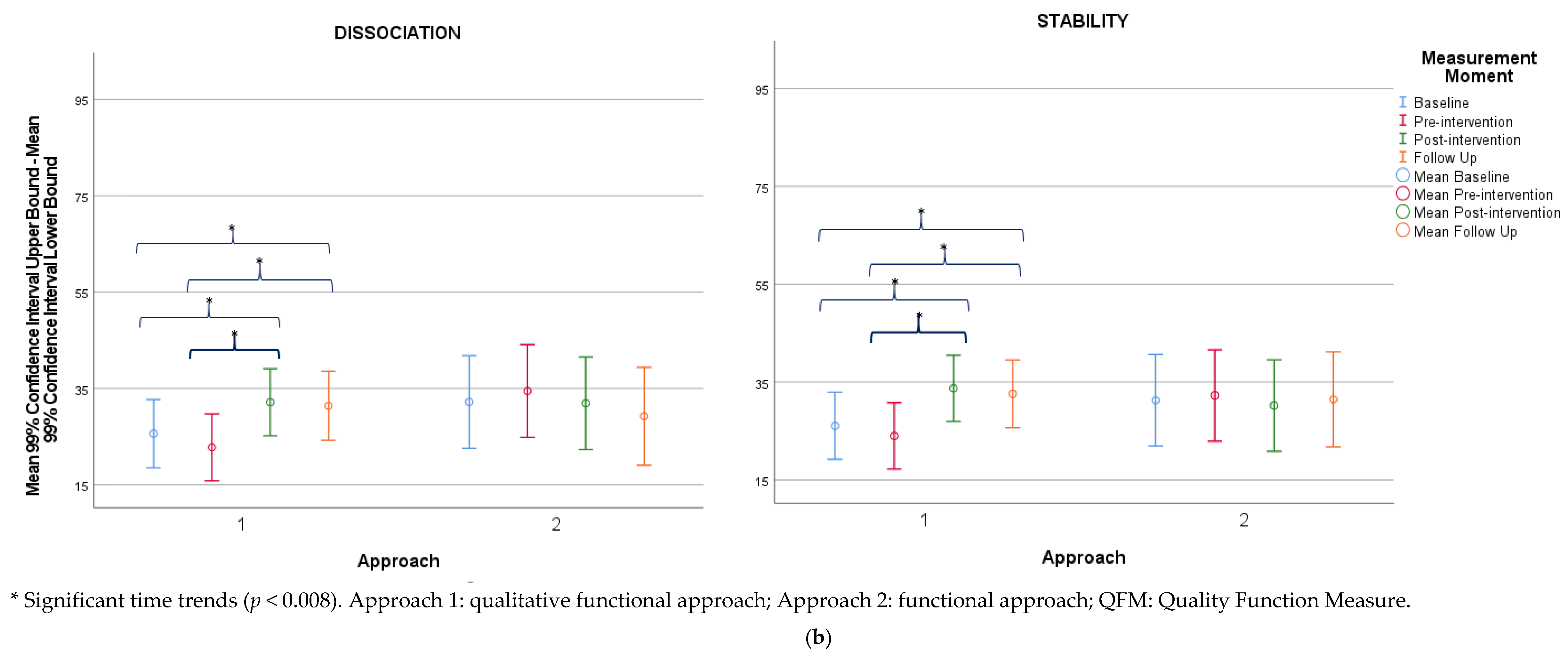
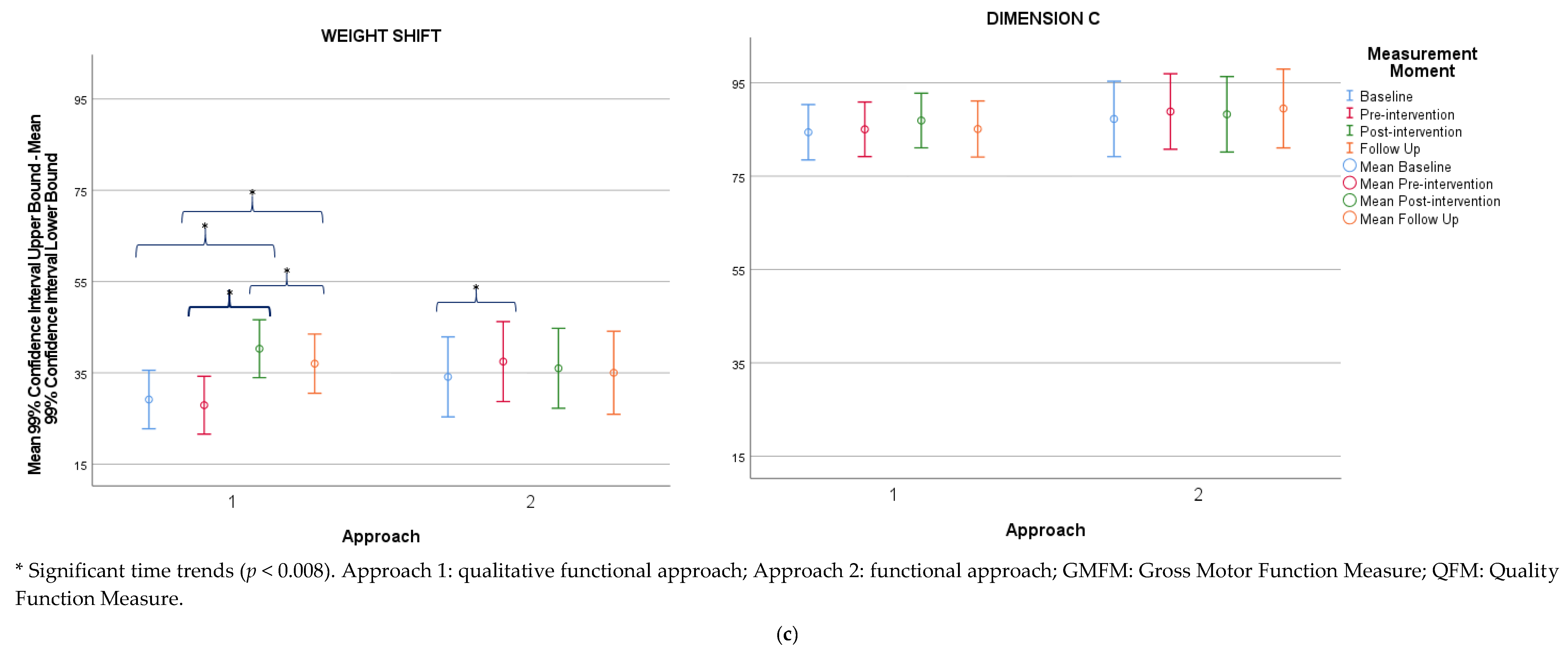
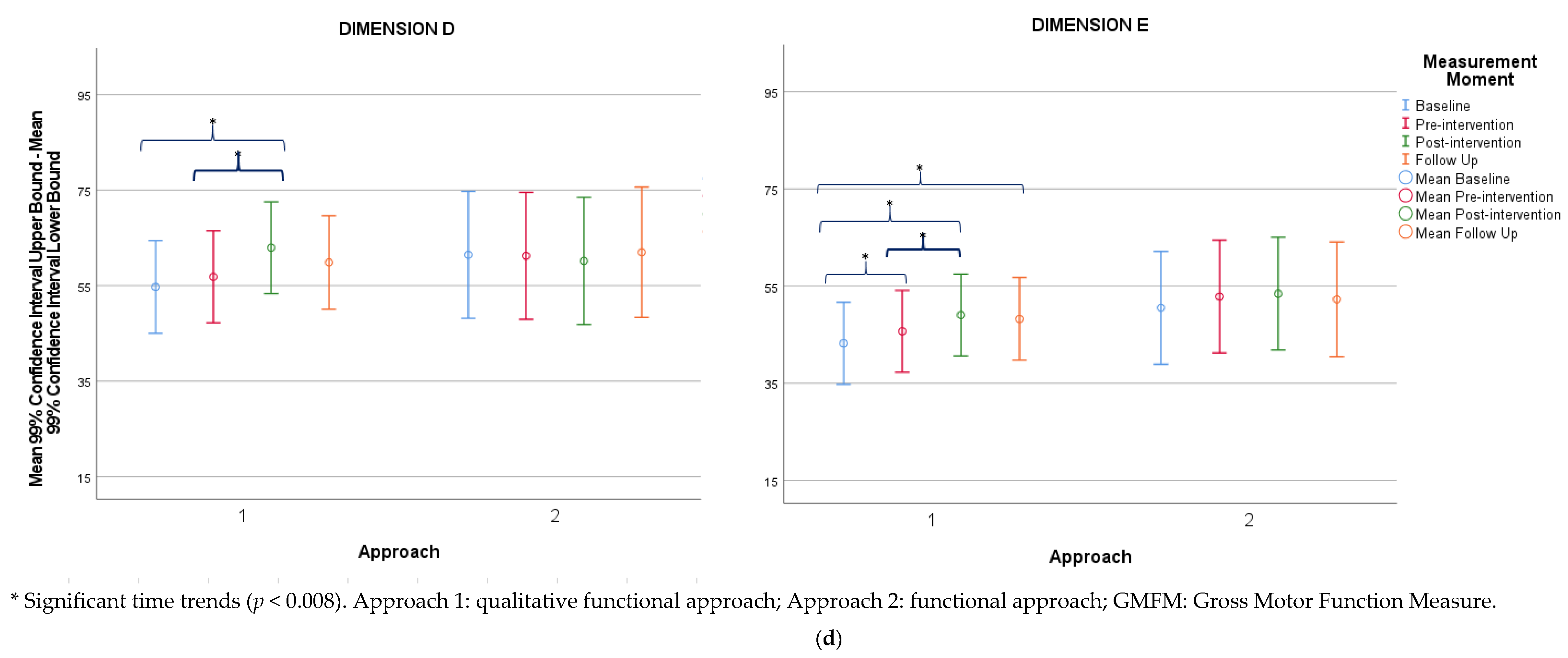
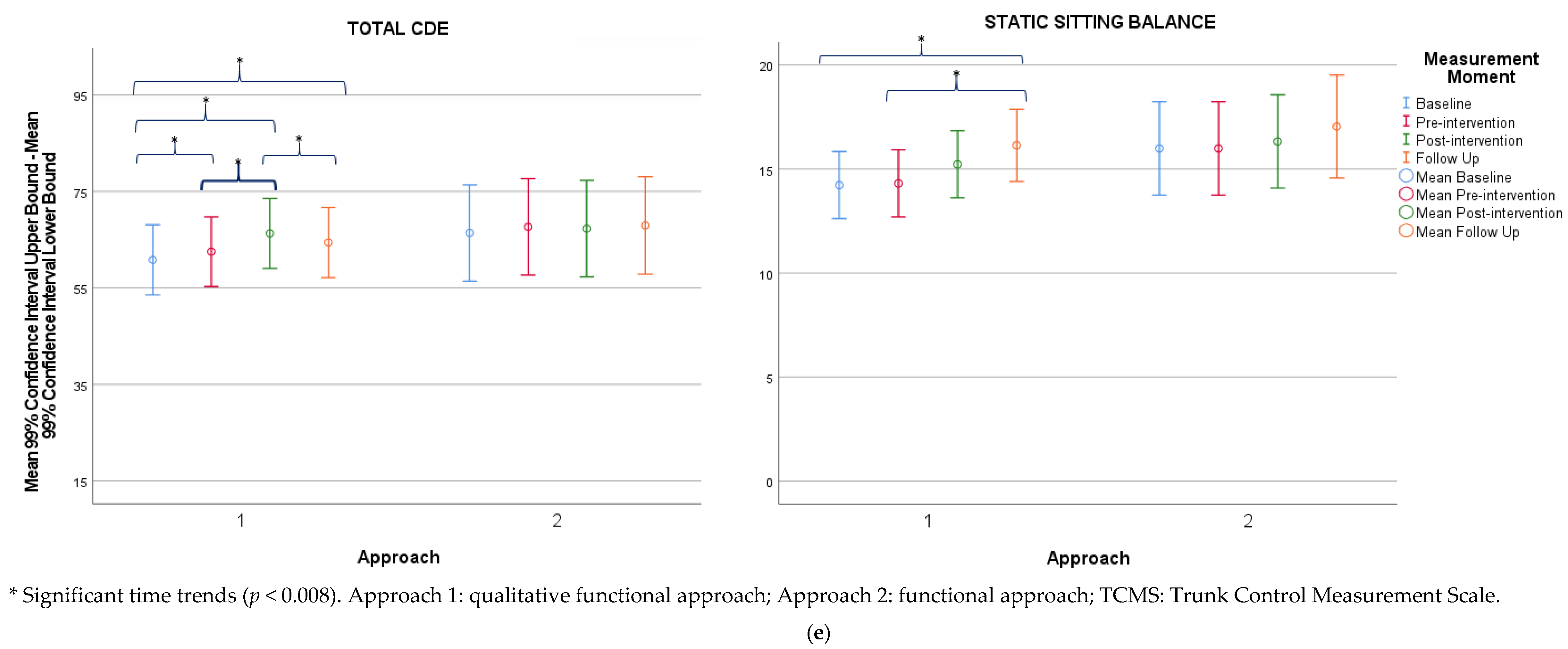
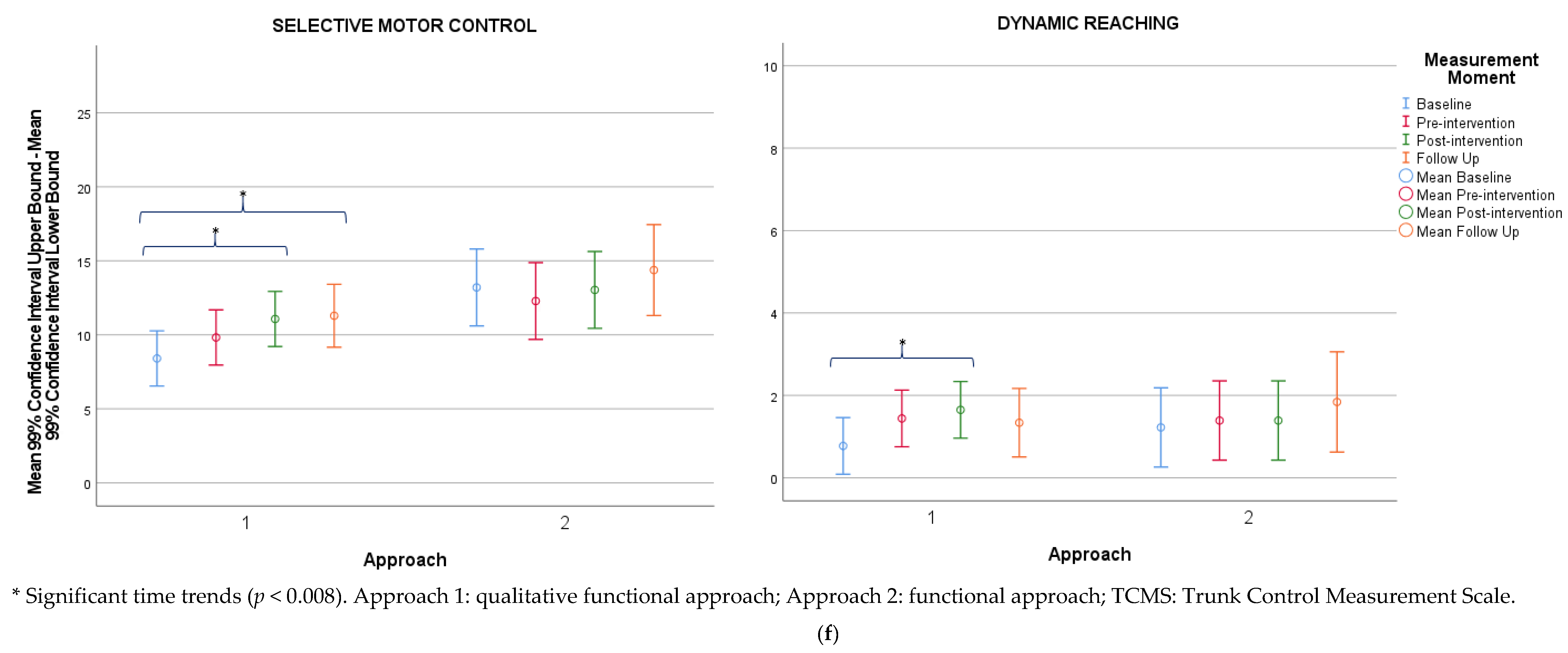
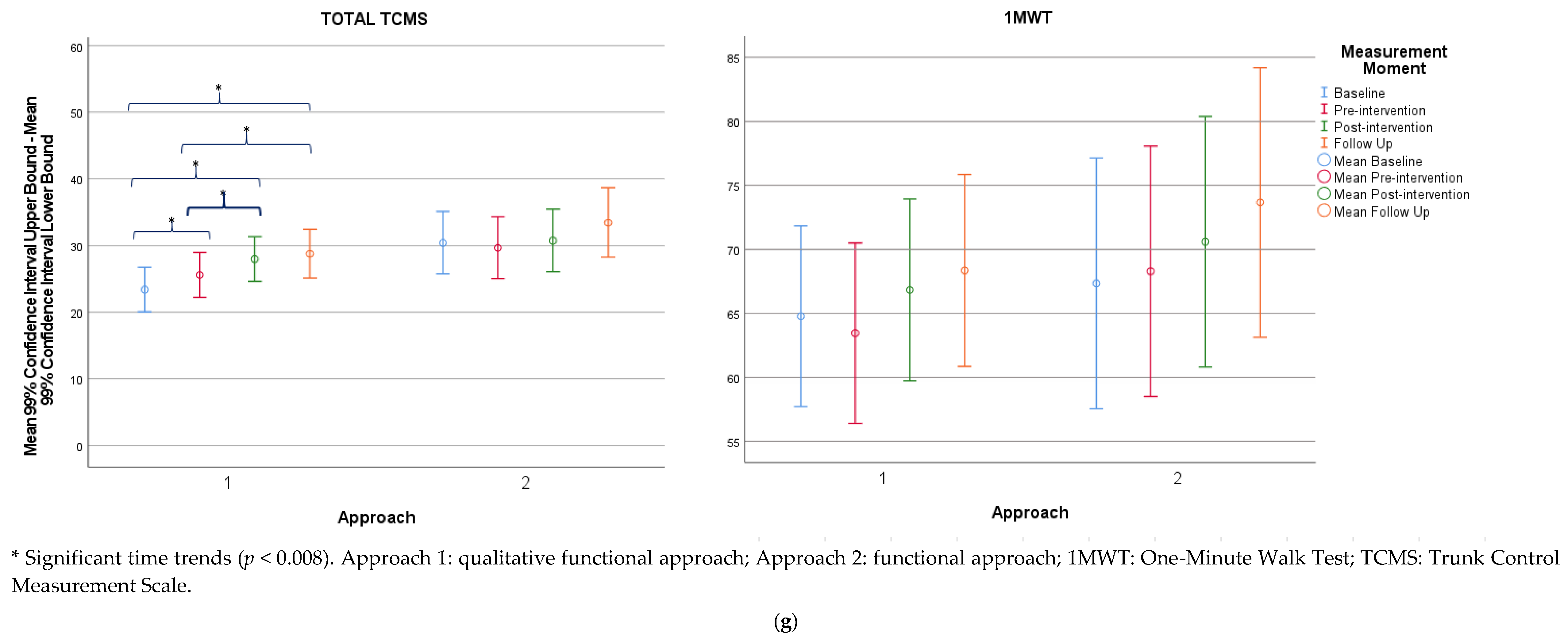
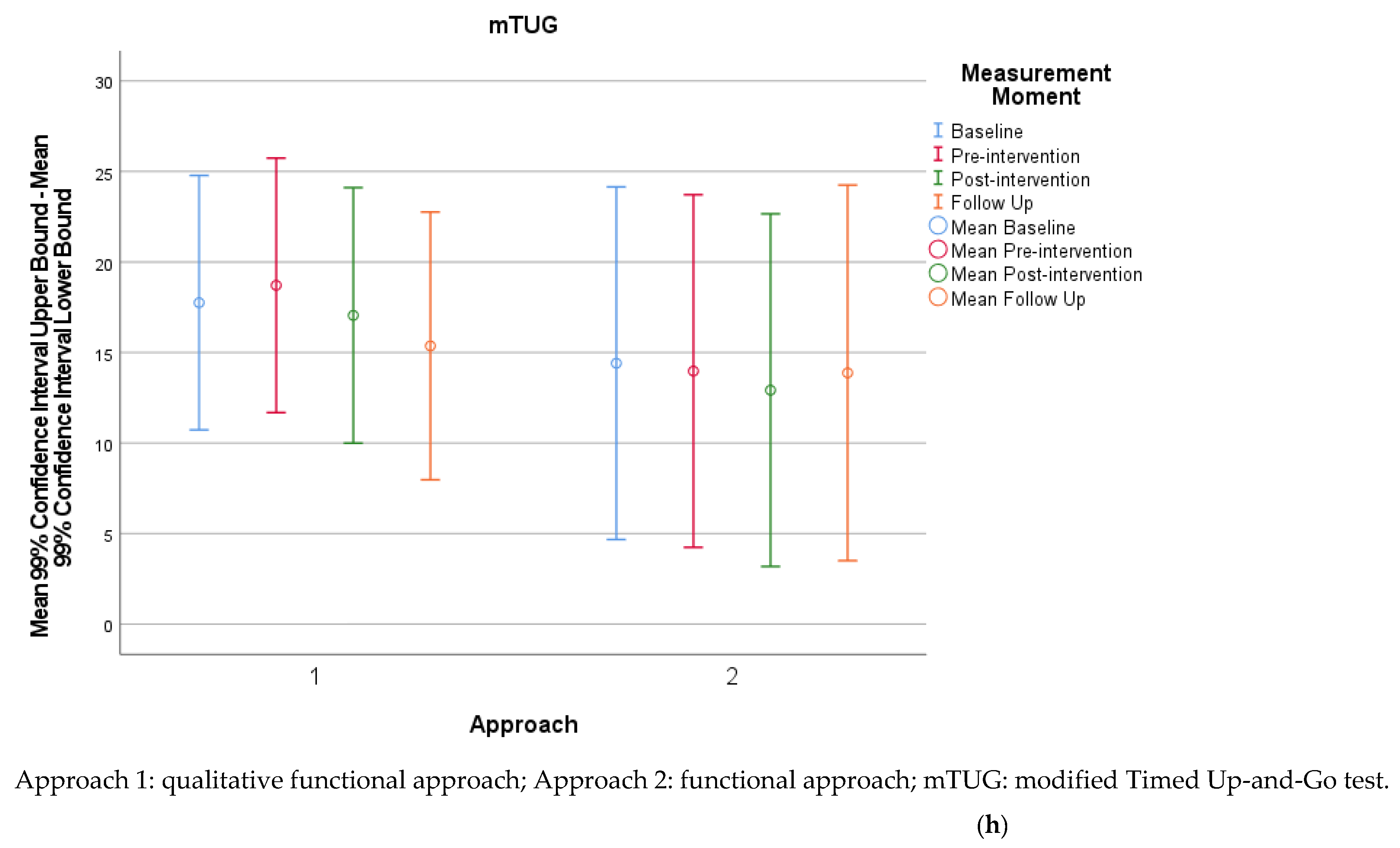
| Qualitative Functional Approach | Functional Approach | Total Group | |||
|---|---|---|---|---|---|
| Number | 24 * | 12 | 36 | ||
| Age (y and m) | Mean (SD) | 8 y 6 m (1.84) | 8 y 10 m (2.23) | 8 y 7 m (1.96) | |
| Sex | |||||
| Female | n (%) | 14 (58) | 3 (25) | 17 (47) | |
| Male | n (%) | 10 (42) | 9 (75) | 19 (53) | |
| GMFCS level | |||||
| II | n (%) | 15 (62) | 7 (58) | 22 (61) | |
| III | n (%) | 9 (37) | 5 (42) | 14 (39) | |
| Lost to follow-up | n (%) | 8 (33) II: 6 (6 BoNT-A) III: 2 (1 ML, 1 SDR) | 5 (42) II: 2 (1 BoNT-A, 1 ML) III: 3 (2 ML, 1 SDR) | 13 (36) |
| Approach | Baseline | Pre-Intervention | Post-Intervention | Follow-Up | Time * Approach | Qualitative Functional (1) | Functional (2) | |
|---|---|---|---|---|---|---|---|---|
| QFM | ||||||||
| Alignment | 1 | 54.68 (28.39) | 48.57 (25.08) | 62.10 (24.68) | 54.08 (36.99) | <0.001 | <0.001 | 0.410 |
| 2 | 49.68 (28.15) | 52.96 (29.48) | 49.63 (31.53) | 61.53 (31.07) | ||||
| Coordination | 1 | 40.15 (21.18) | 35.16 (20.48) | 45.97 (23.40) | 41.88 (24.66) | <0.001 | <0.001 | 0.009 |
| 2 | 42.52 (26.18) | 45.05 (26.80) | 43.51 (26.88) | 44.37 (20.60) | ||||
| Dissociation | 1 | 33.38 (19.51) | 27.46 (17.07) | 36.83 (21.37) | 34.19 (22.61) | <0.001 | <0.001 | 0.095 |
| 2 | 35.46 (22.59) | 37.72 (23.76) | 35.18 (23.36) | 37.71 (19.98) | ||||
| Stability | 1 | 34.49 (19.49) | 29.09 (18.05) | 38.80 (21.73) | 35.01 (22.13) | <0.001 | <0.001 | 0.289 |
| 2 | 35.10 (23.63) | 36.08 (24.62) | 34.02 (24.02) | 40.00 (20.91) | ||||
| Weight shift | 1 | 37.84 (19.77) | 32.97 (18.47) | 45.33 (20.49) | 39.00 (21.43) | <0.001 | <0.001 | 0.020 |
| 2 | 37.74 (22.68) | 41.09 (24.28) | 39.62 (24.18) | 44.73 (22.83) | ||||
| GMFM | ||||||||
| Dimension C | 1 | 89.76 (15.15) | 88.10 (16.16) | 89.98 (13.95) | 86.16 (16.97) | 0.108 | 0.033 | 0.419 |
| 2 | 89.29 (14.27) | 90.87 (13.35) | 90.28 (14.01) | 93.20 (12.93) | ||||
| Dimension D | 1 | 64.36 (25.75) | 62.71 (26.78) | 68.80 (25.61) | 62.34 (29.51) | <0.001 | <0.001 | 0.702 |
| 2 | 65.60 (27.19) | 65.38 (28.71) | 64.32 (27.65) | 71.79 (24.28) | ||||
| Dimension E | 1 | 55.14 (26.11) | 52.26 (27.01) | 55.61 (27.62) | 53.21 (30.48) | 0.185 | <0.001 | 0.116 |
| 2 | 55.21 (30.80) | 57.52 (21.48) | 58.10 (32.99) | 64.88 (28.53) | ||||
| Total CDE | 1 | 69.75 (21.74) | 67.69 (22.41) | 71.47 (21.59) | 67.24 (25.03) | <0.001 | <0.001 | 0.324 |
| 2 | 70.03 (23.39) | 71.26 (24.04) | 70.90 (23.92) | 67.62 (21.14) | ||||
| TCMS | ||||||||
| Static sitting balance | 1 | 14.75 (4.66) | 14.83 (4.42) | 15.75 (3.78) | 16.80 (2.93) | 0.769 | 0.006 | 0.587 |
| 2 | 16.33 (2.77) | 16.33 (3.03) | 16.67 (2.50) | 17.29 (1.50) | ||||
| Selective movement control | 1 | 9.00 (4.76) | 10.42 (4.78) | 11.67 (4.26) | 12.13 (4.42) | 0.077 | 0.003 | 0.290 |
| 2 | 13.83 (5.57) | 12.92 (5.95) | 13.67 (5.07) | 14.43 (5.50) | ||||
| Dynamic reaching | 1 | 0.88 (0.80) | 1.54 (1.53) | 1.75 (1.73) | 1.40 (0.91) | 0.423 | 0.041 | 0.710 |
| 2 | 1.33 (1.23) | 1.50 (1.51) | 1.50 (1.24) | 1.86 (2.27) | ||||
| Total TCMS | 1 | 24.63 (8.95) | 26.79 (9.43) | 29.17 (8.26) | 30.33 (7.44) | 0.780 | <0.001 | 0.162 |
| 2 | 31.50 (9.07) | 30.75 (9.39) | 31.83 (7.78) | 33.57 (8.70) | ||||
| Gait Capacity | ||||||||
| 1MWT | 1 | 67.72 (20.10) | 66.37 (15.85) | 70.85 (16.48) | 72.46 (16.64) | 0.679 | 0.043 | 0.272 |
| 2 | 69.96 (17.01) | 70.88 (18.62) | 73.19 (19.50) | 81.02 (13.51) | ||||
| mTUG | 1 | 15.77 (17.32) | 16.73 (22.76) | 14.40 (15.33) | 15.05 (15.21) | 0.680 | 0.286 | 0.885 |
| 2 | 13.07 (12.08) | 12.64 (12.75) | 11.58 (12.76) | 9.10 (4.70) | ||||
| Alignment | Coordination | Dissociation | Stability | Weight Shift | ||||||||||||||||||
|---|---|---|---|---|---|---|---|---|---|---|---|---|---|---|---|---|---|---|---|---|---|---|
| Approach | Time A | Time B | Mean Difference (A–B) | Significance | Lower Bound | Upper Bound | Mean Difference (A–B) | Significance | Lower Bound | Upper Bound | Mean Difference (A–B) | Significance | Lower Bound | Upper Bound | Mean Difference (A–B) | Significance | Lower Bound | Upper Bound | Mean Difference (A–B) | Significance | Lower Bound | Upper Bound |
| Qualitative functional | 2 | 1 | −2.30 | 0.069 | −5.76 | 1.07 | −1.20 | 0.223 | −3.73 | 1.40 | −2.84 | 0.018 | −6.03 | 0.35 | −2.05 | 0.035 | −4.64 | 0.54 | −1.24 | 0.167 | −3.63 | 1.16 |
| 3 | 1 | 11.23 | <0.001 | 6.78 | 15.69 | 9.65 | <0.001 | 6.23 | 13.07 | 6.53 | <0.001 | 2.32 | 10.74 | 7.67 | <0.001 | 4.23 | 11.11 | 11.13 | <0.001 | 7.95 | 14.31 | |
| 2 | 13.53 | <0.001 | 10.45 | 16.62 | 10.81 | <0.001 | 8.47 | 13.16 | 9.37 | <0.001 | 6.45 | 12.29 | 9.72 | <0.001 | 7.35 | 12.09 | 12.36 | <0.001 | 10.18 | 14.55 | ||
| 4 | 1 | 7.87 | <0.001 | 2.21 | 13.53 | 7.68 | <0.001 | 3.30 | 12.05 | 5.77 | 0.004 | 0.44 | 11.11 | 6.59 | <0.001 | 2.20 | 10.98 | 7.86 | <0.001 | 3.81 | 11.92 | |
| 2 | 10.17 | <0.001 | 5.42 | 14.92 | 8.85 | <0.001 | 5.20 | 12.49 | 8.62 | <0.001 | 4.13 | 13.10 | 8.64 | <0.001 | 4.97 | 12.31 | 9.10 | <0.001 | 5.71 | 12.49 | ||
| 3 | −3.36 | 0.017 | −7.11 | 038 | −2.00 | 0.067 | −4.83 | 0.89 | −0.75 | 0.570 | −4.30 | 2.80 | −1.10 | 0.314 | −3.96 | 1.80 | −3.26 | 0.001 | −5.93 | −0.60 | ||
| Functional | 2 | 1 | 3.28 | 0.045 | −1.08 | 7.65 | 2.53 | 0.043 | −0.79 | 5.85 | 2.27 | 0.142 | −1.87 | 6.40 | 1.00 | 0.435 | −2.38 | 4.33 | 3.35 | 0.004 | 0.26 | 6.45 |
| 3 | 1 | −0.06 | 0.980 | −6.06 | 5.95 | 1.00 | 0.563 | −3.62 | 5.61 | −0.28 | 0.896 | −5.95 | 5.40 | −1.10 | 0.533 | −5.72 | 3.56 | 1.88 | 0.240 | −2.41 | 6.17 | |
| 2 | −3.34 | 0.042 | −7.07 | 1.03 | −1.50 | 0.215 | −4.86 | 1.78 | −2.54 | 0.100 | −6.68 | 1.59 | −2.10 | 0.102 | −5.40 | 1.30 | −1.47 | 0.203 | −4.57 | 1.62 | ||
| 4 | 1 | −1.69 | 0.571 | −9.70 | 6.32 | −3.20 | 0.174 | −9.36 | 3.04 | −2.96 | 0.295 | −10.51 | 4.59 | 0.20 | 0.938 | −6.04 | 6.40 | 0.91 | 0.670 | −4.83 | 6.66 | |
| 2 | −4.97 | 0.059 | −11.97 | 2.02 | −5.69 | 0.005 | −11.06 | −0.32 | −5.22 | 0.036 | −11.83 | 1.38 | −0.80 | 0.693 | −6.20 | 4.61 | −2.44 | 0.192 | −7.43 | 2.56 | ||
| 3 | −1.64 | 0.437 | −7.29 | 4.02 | −4.15 | 0.011 | -8.47 | 0.16 | −2.68 | 0.180 | −8.03 | 2.67 | 1.30 | 0.438 | -3.09 | 5.61 | −0.97 | 0.518 | −4.99 | 3.05 | ||
| Dimension C | Dimension D | Dimension E | Total CDE | |||||||||||||||
|---|---|---|---|---|---|---|---|---|---|---|---|---|---|---|---|---|---|---|
| Approach | Time A | Time B | Mean Difference (A–B) | Significance | Lower Bound | Upper Bound | Mean Difference (A–B) | Significance | Lower Bound | Upper Bound | Mean Difference (A–B) | Significance | Lower Bound | Upper Bound | Mean Difference (A–B) | Significance | Lower Bound | Upper Bound |
| Qualitative functional | 2 | 1 | 0.63 | 0.481 | −1.76 | 3.02 | 2.12 | 0.066 | −0.95 | 5.20 | 2.46 | 0.003 | 0.31 | 4.61 | 1.71 | 0.003 | 0.18 | 3.25 |
| 3 | 1 | 2.51 | 0.035 | −0.66 | 5.68 | 8.21 | <0.001 | 4.10 | 12.31 | 5.82 | <0.001 | 2.93 | 8.71 | 5.49 | <0.001 | 3.43 | 7.55 | |
| 2 | 1.88 | 0.022 | 0.63 | 4.07 | 6.09 | <0.001 | 3.28 | 8.90 | 3.35 | <0.001 | 1.40 | 5.32 | 3.77 | <0.001 | 2.38 | 5.18 | ||
| 4 | 1 | 0.69 | 0.648 | −3.35 | 4.72 | 5.15 | 0.010 | −0.12 | 10.42 | 5.01 | <0.001 | 1.30 | 8.73 | 3.60 | <0.001 | 0.94 | 6.26 | |
| 2 | 0.06 | 0.963 | −3.32 | 3.44 | 3.03 | 0.066 | −1.36 | 7.41 | 2.55 | 0.028 | −0.53 | 5.63 | 1.89 | 0.023 | −0.31 | 4.09 | ||
| 3 | −1.83 | 0.067 | −4.49 | 0.83 | −3.06 | 0.018 | −6.49 | 0.36 | −0.80 | 0.369 | −3.20 | 1.60 | −1.89 | 0.004 | −3.60 | −0.18 | ||
| Functional | 2 | 1 | 1.59 | 0.170 | −1.51 | 4.68 | −0.21 | 0.885 | −4.19 | 3.76 | 2.31 | 0.027 | −0.47 | 5.10 | 1.20 | 0.097 | −0.75 | 3.21 |
| 3 | 1 | 0.99 | 0.533 | −3.28 | 5.26 | −1.28 | 0.535 | −6.82 | 4.26 | 2.89 | 0.048 | −1.00 | 6.79 | 0.90 | 0.403 | −1.91 | 3.65 | |
| 2 | −0.60 | 0.605 | −3.69 | 2.50 | −1.07 | 0.471 | −5.05 | 2.91 | 0.58 | 0.576 | −2.20 | 3.46 | −0.40 | 0.624 | −2.34 | 1.62 | ||
| 4 | 1 | 2.22 | 0.298 | −3.49 | 7.93 | 0.54 | 0.846 | −6.92 | 8.00 | 1.75 | 0.374 | −3.52 | 7.02 | 1.50 | 0.277 | −2.24 | 5.30 | |
| 2 | 0.63 | 0.732 | −4.34 | 5.61 | 0.75 | 0.754 | −5.70 | 7.21 | −0.57 | 0.737 | −5.11 | 3.97 | 0.30 | 0.802 | −2.94 | 3.54 | ||
| 3 | 1.23 | 0.411 | −2.78 | 5.24 | 1.82 | 0.345 | −3.45 | 7.00 | −1.15 | 0.396 | −4.77 | 2.48 | 0.70 | 0.491 | −1.92 | 3.25 | ||
| Static Sitting Balance | Selective Motor Control | Dynamic Reaching | Total TCMS | |||||||||||||||
|---|---|---|---|---|---|---|---|---|---|---|---|---|---|---|---|---|---|---|
| Approach | Time A | Time B | Mean Difference (A–B) | Significance | Lower Bound | Upper Bound | Mean Difference (A–B) | Significance | Lower Bound | Upper Bound | Mean Difference (A–B) | Significance | Lower Bound | Upper Bound | Mean Difference (A–B) | Significance | Lower Bound | Upper Bound |
| Qualitative functional | 2 | 1 | 0.08 | 0.810 | −0.85 | 1.01 | 1.42 | 0.013 | −0.09 | 2.93 | 0.67 | 0.017 | −0.07 | 1.41 | 2.17 | 0.006 | 0.10 | 4.24 |
| 3 | 1 | 1.00 | 0.033 | −0.25 | 2.25 | 2.67 | <0.001 | 0.75 | 4.58 | 0.87 | 0.007 | 0.02 | 1.73 | 4.54 | <0.001 | 1.79 | 7.29 | |
| 2 | 0.92 | 0.009 | 0.01 | 1.85 | 1.25 | 0.028 | −0.26 | 2.76 | 0.21 | 0.448 | −0.53 | 0.95 | 2.37 | 0.003 | 0.30 | 4.45 | ||
| 4 | 1 | 1.92 | 0.002 | 0.32 | 3.52 | 2.89 | 0.001 | 0.52 | 5.26 | 0.56 | 0.141 | −0.45 | 1.58 | 5.34 | <0.001 | 1.83 | 8.86 | |
| 2 | 1.83 | 0.001 | 0.41 | 3.26 | 1.48 | 0.072 | −0.71 | 3.66 | −0.11 | 0.774 | −1.08 | 0.87 | 3.18 | 0.008 | 0.04 | 6.31 | ||
| 3 | 0.92 | 0.035 | −0.24 | 2.07 | 0.23 | 0.742 | −1.61 | 2.06 | −0.31 | 0.337 | −1.19 | 0.56 | 0.80 | 0.402 | −1.76 | 3.36 | ||
| Functional | 2 | 1 | 0.00 | 1.000 | −1.32 | 1.32 | −0.92 | 0.249 | −3.05 | 1.22 | 0.17 | 0.667 | −0.88 | 1.00 | −0.80 | 0.492 | −3.68 | 2.18 |
| 3 | 1 | 0.33 | 0.612 | −1.43 | 2.10 | −0.17 | 0.869 | −2.87 | 2.54 | 0.17 | 0.713 | −1.05 | 1.38 | 0.33 | 0.818 | −3.56 | 4.22 | |
| 2 | 0.33 | 0.497 | −1.98 | 1.65 | 0.75 | 0.346 | −1.38 | 2.99 | 0.00 | 1.000 | −1.04 | 1.04 | 1.08 | 0.322 | −1.85 | 4.01 | ||
| 4 | 1 | 1.05 | 0.222 | −1.25 | 3.36 | 1.16 | 0.364 | −2.25 | 4.58 | 0.61 | 0.265 | −0.85 | 2.08 | 3.01 | 0.113 | −2.05 | 8.07 | |
| 2 | 1.05 | 0.171 | −1.00 | 3.11 | 2.08 | 0.080 | −1.08 | 5.23 | 0.45 | 0.400 | −1.97 | 1.86 | 3.76 | 0.028 | −0.78 | 8.29 | ||
| 3 | 0.72 | 0.253 | −0.97 | 2.41 | 1.33 | 0.185 | −1.35 | 4.01 | 0.45 | 0.348 | −0.83 | 1.72 | 2.68 | 0.057 | −1.07 | 6.42 | ||
| 1MWT | mTUG | |||||||||
|---|---|---|---|---|---|---|---|---|---|---|
| Approach | Time A | Time B | Mean Difference (A–B) | Significance | Lower Bound | Upper Bound | Mean Difference (A–B) | Significance | Lower Bound | Upper Bound |
| Qualitative functional | 2 | 1 | −1.35 | 0.299 | −4.85 | 2.14 | 0.96 | 0.418 | −2.21 | 4.12 |
| 3 | 1 | 2.05 | 0.252 | −2.74 | 6.84 | −0.71 | 0.666 | −5.08 | 3.67 | |
| 2 | 3.40 | 0.012 | −0.16 | 6.97 | −1.66 | 0.170 | −4.89 | 1.57 | ||
| 4 | 1 | 3.57 | 0.124 | −2.61 | 9.75 | −2.38 | 0.264 | −8.06 | 3.31 | |
| 2 | 4.92 | 0.017 | −0.52 | 10.36 | −3.33 | 0.074 | −8.31 | 1.64 | ||
| 3 | 1.52 | 0.305 | −2.84 | 5.88 | −1.67 | 0.258 | −5.63 | 2.29 | ||
| Functional | 2 | 1 | 0.91 | 0.619 | −4.03 | 5.86 | −0.43 | 0.795 | −4.91 | 4.05 |
| 3 | 1 | 3.22 | 0.199 | −3.48 | 9.93 | −1.49 | 0.515 | −7.61 | 4.64 | |
| 2 | 2.31 | 0.211 | −2.63 | 7.25 | −1.06 | 0.527 | −5.54 | 3.43 | ||
| 4 | 1 | 6.32 | 0.058 | −2.53 | 15.18 | −0.54 | 0.858 | −8.68 | 7.59 | |
| 2 | 5.41 | 0.065 | −2.40 | 13.22 | −0.11 | 0.967 | −7.25 | 7.03 | ||
| 3 | 3.10 | 0.193 | −3.27 | 9.47 | 0.95 | 0.661 | −4.84 | 6.73 | ||
| QFM | |||||
| Alignment | Coordination | Dissociation | Stability | Weight shift | |
| Approach 1 | 0.54 | 0.49 | 0.49 | 0.49 | 0.63 |
| Approach 2 | −0.11 | −0.06 | −0.11 | −0.08 | −0.06 |
| GMFM | |||||
| Dimension C | Dimension D | Dimension E | Total CDE | ||
| Approach 1 | 0.13 | 0.23 | 0.12 | 0.17 | |
| Approach 2 | −0.04 | −0.04 | 0.02 | −0.02 | |
| TCMS | |||||
| Static sitting balance | Selective motor control | Dynamic reaching | Total TCMS | ||
| Approach 1 | 0.22 | 0.28 | 0.14 | 0.26 | |
| Approach 2 | 0.12 | 0.14 | 0.00 | 0.13 | |
| 1MWT | mTUG | ||||
| Approach 1 | 0.28 | 0.12 | |||
| Approach 2 | 0.12 | 0.06 | |||
| Qualitative Functional Approach | Functional Approach | |||
|---|---|---|---|---|
| MCD | MCID | Mean Difference | Mean Difference | |
| QFM (%) | ||||
| Alignment | 13.5 | / | 13.5 | −3.3 |
| Coordination | 8.7 | / | 10.8 | −1.5 |
| Dissociation | 8.4 | / | 9.40 | −2.5 |
| Stability | 9.9 | / | 9.70 | −2.0 |
| Weight shift | 8.4 | / | 12.60 | −1.5 |
| GMFM (%) | ||||
| Dimension C | 7.90 | / | 1.88 | −0.59 |
| Dimension D | 7.23 | 6.09 | −1.07 | |
| II | 3.3 | 5.46 | −1.10 | |
| III | 4.1 | 6.83 | −1.03 | |
| Dimension E | 4.16 | 3.36 | 0.58 | |
| II | 4.5 | 4.26 | 0.99 | |
| III | 3.4 | 1.85 | 0.00 | |
| TCMS | ||||
| Total TCMS | 6 | / | 2.38 | 1.08 |
| Gait capacity | ||||
| 1MWT (m) | / | |||
| II | 5.1 | 3.8 | 2.7 | |
| III | 3.8 | 2.7 | 1.7 | |
| mTUG (s) | / | |||
| II | 0.7 | 0.8 | 0.4 | |
| III | 1.2 | 3.3 | 2.0 | |
Disclaimer/Publisher’s Note: The statements, opinions and data contained in all publications are solely those of the individual author(s) and contributor(s) and not of MDPI and/or the editor(s). MDPI and/or the editor(s) disclaim responsibility for any injury to people or property resulting from any ideas, methods, instructions or products referred to in the content. |
© 2023 by the authors. Licensee MDPI, Basel, Switzerland. This article is an open access article distributed under the terms and conditions of the Creative Commons Attribution (CC BY) license (https://creativecommons.org/licenses/by/4.0/).
Share and Cite
van Tittelboom, V.; Heyrman, L.; De Cat, J.; Algoet, P.; Peeters, N.; Alemdaroğlu-Gürbüz, I.; Plasschaert, F.; Van Herpe, K.; Molenaers, G.; De Bruyn, N.; et al. Intensive Therapy of the Lower Limbs and the Trunk in Children with Bilateral Spastic Cerebral Palsy: Comparing a Qualitative Functional and a Functional Approach. J. Clin. Med. 2023, 12, 4078. https://doi.org/10.3390/jcm12124078
van Tittelboom V, Heyrman L, De Cat J, Algoet P, Peeters N, Alemdaroğlu-Gürbüz I, Plasschaert F, Van Herpe K, Molenaers G, De Bruyn N, et al. Intensive Therapy of the Lower Limbs and the Trunk in Children with Bilateral Spastic Cerebral Palsy: Comparing a Qualitative Functional and a Functional Approach. Journal of Clinical Medicine. 2023; 12(12):4078. https://doi.org/10.3390/jcm12124078
Chicago/Turabian Stylevan Tittelboom, Vanessa, Lieve Heyrman, Josse De Cat, Patrick Algoet, Nicky Peeters, Ipek Alemdaroğlu-Gürbüz, Frank Plasschaert, Katrin Van Herpe, Guy Molenaers, Nele De Bruyn, and et al. 2023. "Intensive Therapy of the Lower Limbs and the Trunk in Children with Bilateral Spastic Cerebral Palsy: Comparing a Qualitative Functional and a Functional Approach" Journal of Clinical Medicine 12, no. 12: 4078. https://doi.org/10.3390/jcm12124078
APA Stylevan Tittelboom, V., Heyrman, L., De Cat, J., Algoet, P., Peeters, N., Alemdaroğlu-Gürbüz, I., Plasschaert, F., Van Herpe, K., Molenaers, G., De Bruyn, N., Deschepper, E., Desloovere, K., Calders, P., Feys, H., & Van den Broeck, C. (2023). Intensive Therapy of the Lower Limbs and the Trunk in Children with Bilateral Spastic Cerebral Palsy: Comparing a Qualitative Functional and a Functional Approach. Journal of Clinical Medicine, 12(12), 4078. https://doi.org/10.3390/jcm12124078







